Posts Tagged ‘Julia Gillard’
Sunday, January 15th, 2012
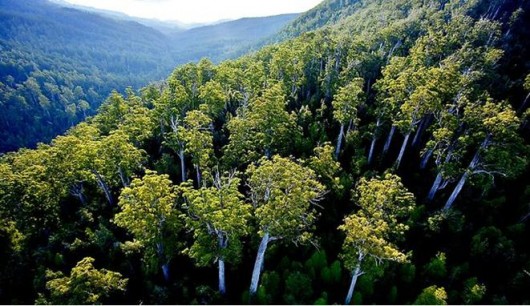 Tasmania’s magnificent ‘Weld Forest’
~ one of Tasmania’s rare ancient forests constantly threatened
by Tasmanian Government recidivist logger ‘Forestry Tasmania’ Tasmania’s magnificent ‘Weld Forest’
~ one of Tasmania’s rare ancient forests constantly threatened
by Tasmanian Government recidivist logger ‘Forestry Tasmania’
.
Australia’s Gillard Labor Government yesterday (20120114) announced an ‘interim legal protection for 428,000 ha’ ahead of tomorrow’s scheduled return of recidivist logging.
This appears good news which obviously the Gillard media release intends. But the process is duplicitous and sly.
Tasmania’s 2011 Forests Agreement is a community agreement about public forest protection involving taxpayer funded Forestry Tasmania so what moral right does the Labor Party have to deny the process being public – i.e. transparent and open? Why is the forest map not publicly online showing the updates of the discussions? Which 1950ha get the chainsaw and why?
This is the only available map. [Read Tasmanian Forest Protection Map 2011]
Professor Jonathan West, Chair of the Independent Verification Group has a lot to answer for. Why has he not voiced outrage publicly of Forestry Tasmania’s illegal logging of the 430.000 hectares of native forests protected in Interim Reserves under the Agreement?
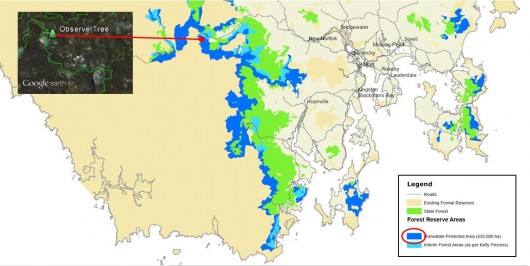
Relative position of the local Tasmanian community protest tree sit The Observer Tree
For ongoing updates visit The ObserverTree.org
.
 Tasmania’s Forest Defender – Miranda Gibson
stationed in a eco-Tree Sit 60 metres above the Styx Valley Forest floor
Visit: The ObserverTree.org
…waiting for Australia’s Prime Minister Julia Gillard to honour her personal promise to Tasmanians to protect Tasmanian old growth forests for perpetuity.
. Tasmania’s Forest Defender – Miranda Gibson
stationed in a eco-Tree Sit 60 metres above the Styx Valley Forest floor
Visit: The ObserverTree.org
…waiting for Australia’s Prime Minister Julia Gillard to honour her personal promise to Tasmanians to protect Tasmanian old growth forests for perpetuity.
.
572,000 hectares of Tasmania’s remaining old growth
…’as agreed‘ Julia!
.
‘Tassie forests deal like a Gunn to the head’
[Source: ‘Tassie forests deal like a Gunn to the head’, by political journalist Bruce Montgomery in Hobart, ^http://www.crikey.com.au/2011/09/06/tasmanian-forrests-deal-gillard-and-giddings/]above the Styx
.
‘The $276 million agreement that Prime Minister Julia Gillard and Tasmanian Premier Lara Giddings flaunted only a month ago as the ultimate peace deal to end the 40-year war in Tasmania’s forests is dead in the water. It comes as no surprise to those who have sought to interpret the poorly drafted provisions of the intergovernmental agreement (IGA) signed by Gillard and Giddings and those of the agreement that preceded it, the so-called Statement of Principles.
The Statement of Principles was the product of those purporting to represent the Tasmanian forest industry and the conservation movement to achieve a peace, most recently under the guidance of former ACTU secretary Bill Kelty.
Both documents appear to have been the work of plant operators rather than draftspeople. Grammar and proofing blunders aside, the giant flaw in both agreements has been the right of conservation groups to identify and nominate another half a million hectares of Crown land in Tasmania to be annexed into reserves, perhaps to the status of national parks or World Heritage, in order to neuter, by law, the timber industry in Tasmania and to pay alms to its victims.
Private foresters, who manage 26% of the total forest cover, were excluded from the negotiations on the pretext that the talks did not involve forests on private land, yet clause 31 of the IGA specifically drags 885,000 hectares of private forests into the equation.
Such a deal, whether concluded at NGO or government level, was never going to pass Tasmania’s Upper House, the Legislative Council. If it did come to pass, it would seal the fate of the Labor-Green governments in Canberra and Hobart as far as Tasmanian voters were concerned.
The premise for the Statement of Principles and the IGA was that the major industrial player, Gunns, was getting out of native forest logging in favour of plantations in order to swing public and banker support behind its $2.5 billion pulp mill proposal at Long Reach on the Tamar River.
In effect, Gunns was about to place all its eggs in one basket, a world-scale pulp mill using only plantation timber. Both agreements hinged on Gunns getting government compensation for its departure from public native forests, yet the mood in Tasmania has clearly been that Gunns should get nothing; its exit from native forests was being made on purely commercial grounds; it was immaterial that it had residual rights to use the public native forests.
If the Giddings government had been responsible for giving Gunns one red cent from the overall $276 million compensation package for the IGA, it would have faced political and electoral oblivion.
We don’t know what Gunns was offered in the end. It is thought to have been $23 million, but on the proviso that it pay its debts to Forestry Tasmania, a disputed $25 million.
Yesterday the Tasmanian government confirmed Gunns had rejected the offer, though Gunns, which has been in a trading halt on the stock exchange since August 8, said nothing.
Assuming that is right, it has the option to place those forest rights on the market. Since the IGA depends on those forests being protected, the keystone to the agreement is gone.’
.
‘Tasmanian forest deal riles green groups‘
[Source: ‘Tasmanian forest deal riles green groups’, by Lanai Vasek and Matthew Denholm, ‘The Australian’, 20120113, The Australian: ^http://www.theaustralian.com.au/national-affairs/tasmanian-forest-deal-riles-green-groups/story-fn59niix-1226243780040]
.
The Gillard Labor Government has announced interim legal protection for 428,000 ha of Tasmania’s forests, but has been accused of reneging on a deal to deliver a larger logging ban.
 Australia’s 27th Prime Minister, The Hon. Julia Gillard (June 2010 – ?)
In her vital and privileged position, she has the power, influence, connections and taxpayer resources
to protect Tasmania’s 572,000 hectares of old growth native forests consistent with the IGA.
As usual, it comes down to political will, courage and innovative thinking – which is what we expect of our leaders. Australia’s 27th Prime Minister, The Hon. Julia Gillard (June 2010 – ?)
In her vital and privileged position, she has the power, influence, connections and taxpayer resources
to protect Tasmania’s 572,000 hectares of old growth native forests consistent with the IGA.
As usual, it comes down to political will, courage and innovative thinking – which is what we expect of our leaders.
.
Environment Minister Tony Burke announced the move today after the Greens suspended normal relations with the government in protest at continues logging of areas deemed sensitive.
The new Conservation Agreement with the Tasmanian Government falls 1950ha short of the forest protection promised under last year’s intergovernmental agreement (IGA) between the Gillard and Giddings governments.
This provoked an angry reaction from environment groups, who said it had “shaken” their confidence in the two governments’ ability to deliver a broader agreement to protect up to 572,000ha.
And Greens leader Bob Brown said it was “a blueprint for the destruction of more than 20 square kilometres of high-conservation value forests”.
…The agreement provides legal protection to the area until an independent process decides how much of the larger area of 572,000ha deserves protection and can be locked up without harming existing timber contracts.
Mr Burke said the new interim deal was good for both forest conservation and jobs and would allow all parties to focus on supporting the longer-term independent verification process, expected to complete by June.
“With this agreement in place, all parties can now concentrate their efforts on assisting the important work of the Independent Verification Group, which is assessing the conservation values of the entire 572,000ha nominated by environmental non-governmental organisations, in addition to verifying long-term timber supply requirements,” Mr Burke said.
“This is a good result for Tasmania’s forestry industry, for local jobs and communities while protecting Tasmania’s iconic forests.”
However, the Wilderness Society, the Australian Conservation Foundation and Environment Tasmania all condemned the two governments for allowing logging in the 1950 ha, saying this included iconic, ancient forests in the Styx Valley, Weld Valley and The Tarkine, including endangered species habitat.
Earlier this week Greens leader Bob Brown said he would not resume his regular meetings with Julia Gillard once parliament returns next month unless she committed to ending logging. This afternoon, Senator Brown said he remained open to ad-hoc talks with Ms Gillard, who will visit Tasmania on the weekend, but accused her of reneging on the promise to protect the full 430,000ha in the IGA announced in August last year.
.
How is Tasmania’s Premier Lara Giddings dealing with the colonial cultural right to log Tasmania’s remaining ancient forests?
Only when Tasmania’s condemned old growth forest is ultimately logged, will neanderthal loggers ugg…
.
‘Where’s me big trees gone’ ?
 . .
Bill Kelty’s drafting of the IGA was a contradictory hoodwink
.
While the public message is $276 million (no less) to exit native forests and a logging moratorium, what is Lara Giddings saying privately to Forestry that we see its business as usual pursuing old growth logging self-righteously on its perceived right to log?
Under the conservation agreement, the Tasmanian government agency Forestry Tasmania is restrained from logging swathes of disputed public forest while the deal is settled. However, evidence has been found of Forestry Tasmania continuing to penetrate its logging deep into these wilderness forests. Meanwhile the contradictory message by the Giddings Labor Government to the Tasmanian forest industry is that it has a ‘guaranteed wood supply‘.
Perhaps having the $276 million cake she says its ok to log the forest too!
In 2004 the Timber Workers for Forests (TWFF) defended their “statutory requirement that a minimum of 300,000 m3 of high quality Eucalypt veneer and sawlog be made available annually.” It’s ‘Logging Statutory Requirement‘ versus ‘Native Logging Moratorium‘ allowing a duplicitous and sly parallel government message process.
Bill Kelty’s drafting of the IGA was worse that a compromise. Its complex and contradictory legalese was a hookwink. Kelty’s wording allowed Forestry to have its cake and eat it. On the one hand it promises Conservation (lumped as “ENGO’s”) under Clauses 25, 26 and 27 …”The State will immediately place the 430,000 ha of native forest…into Informal Reserves.”
While at the same time it also guarantees Forestry wood supply for the remaining industry under Clause 17…”At least 155 000 thousand cubic metres per year of high quality sawlog, by regulation, 265 000 metres per year of peeler billets, a speciality timber supply, noting that the industry claim is 12,500 cubic metres per year, subject to verification.”
So Forestry has has a window of logging opportunity to go for it while Professor Jonathan West’s Independent Verification Group decides the exact boundaries of the 430,000 and 572,000 for either protection or the chainsaw (Clause 20). That decision was due 31st Dec 2011, two weeks ago.
.
“It is little wonder that many Tasmanians now worry that the woodchippers’ greed destroys not only their natural heritage, but distorts their parliament, deforms their polity and poisons their society. And perhaps it is for that reason that the battle for forests in Tasmania is as much about free speech and democracy – about a people’s right to exercise some control over their destiny, about their desire to have a better, freer society – as it is about wild lands.”
[Source: ‘Out of Control: The tragedy of Tasmania’s forests’, by Richard Flanagan, in The Monthly, May 2007, ^http://www.themonthly.com.au/monthly-essays-richard-flanagan-out-control-tragedy-tasmania-s-forests-512]
.
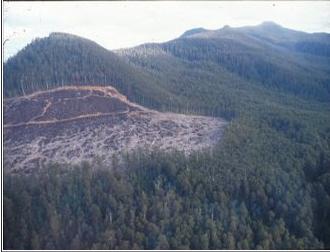 Logging invades Tasmania’s South-West wilderness in the Huon valley,
not far downstream of the above photo.
This logging is ruining the integrity of the adjacent Tasmanian Wilderness World Heritage Area
whose boundaries have been drawn to protect the treeless mountaintops
and leave the forested valleys to the loggers. Logging invades Tasmania’s South-West wilderness in the Huon valley,
not far downstream of the above photo.
This logging is ruining the integrity of the adjacent Tasmanian Wilderness World Heritage Area
whose boundaries have been drawn to protect the treeless mountaintops
and leave the forested valleys to the loggers.
.
Tags: Bill Kelty, Forestry Tasmania, Gillard Labor Government, Independent Verification Group, Julia Gillard, Labor Party, Lara Giggings, old growth forest, recidivist logging, Tasmania, Tasmanian Forests Intergovernmental Agreement, Weld Forest
Posted in + Wild Tasmania, Tasmania (AU), Threats from Deforestation | No Comments »
Add this post to Del.icio.us - Digg
Wednesday, January 11th, 2012
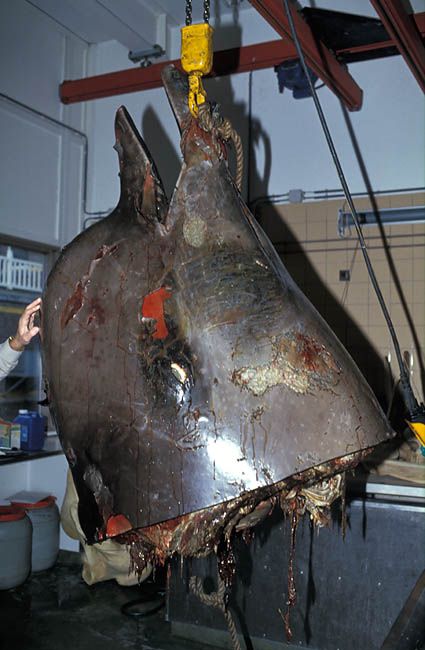 The Japanese kill bottlenose whales
(Photo: Save the Whales) The Japanese kill bottlenose whales
(Photo: Save the Whales)
.
If there is one redeeming legacy about previous British Tory Prime Minister Margaret Thatcher, despite the recurring criticism of her policies and leadership style by many Leftists, is that she was a political leader of strong convictions who commanded respect from foreign powers at a time when it was critical for Great Britain to stand by its principles.
Thatcher defended British sovereignty – its land, its people, its currency.
Not so Australia’s Labor-apparatchik installed puppet Prime Minister, Julia Gillard, who in pursuit of Rudd populism guided not by internal principle but by factions and focus groups is our chair warming PM of unprincipled mediocrity. Since her education revolution as Education Minister her costly results have been mediocre. Where are her principles? – ‘there will be no carbon tax under a government I lead‘, her extravagant $47 billion NBN without any cost-benefit study, her Malaysian solution for asylum seekers, her selling uranium to India against Labor principles and her appeasing foreign interests at Australia’s expense – US pharmaceutical and military interests, China’s mining and manufacturing interests, India’s nuclear interests and free trade with Indonesia, Malaysia and now Mexico and South American nations.
Clearly Ruddism drives Gillard foreign policy. All Gillard need do is fly in, deliver the speech and smile for the cameras, with Rudd up the back somewhere gesturing. Gillard abandoned Australia’s free speech defender Julian Assange and sided with the US Military. Japanese pirate whalers invade Australia’s Southern Ocean whale sanctuary to poach minke whales, endangered fin whales and threatened humpbacks. They now formal Japanese military support having brought their own guardian warship. Gillard doesn’t know what to do. She has a policy vacuum when it comes to the Environment, just like Labor siblings Garrett, Wong and Burke.
Rudd failed to honour his 2007 pledge to formally challenge Japanese whaling in the International Court of Justice. Only public outcry forced the Gillard Government to lodge its case with the court in May 2010. All Gillard does this time around with non-violent action group Forest Rescue boarding the Japanese whaling vessel Shonan Maru is to think legal and appeasing the pirate Japanese. Gillard has slammed the actions of three anti-whaling protesters as “unacceptable” and warned that others who carry out similar protests will be “charged and convicted”. However, the government should be preventing crimes in our near oceans, and illegal whaling, not condemning the actions of law-enforcers trying to do what they should be doing!
Gillard is gutless. Whaling is a sport. It is not scientific. It is not a primary industry because there is stuff all market for whale meat and the only way it is sold is because the Japanese Government subsidises the cost. Whaling is a cultural sport only and a backward cultural one at that. It is all about game.
The Japanese are traditionally a patriarchal society. Japanese males violating Australian waters for foreign whales for sport is consistent with Japanese male cultural history of violating foreign women they euphemistically called ‘comfort women’. Such Japanese culture is backward and foreign and has no place in Australian waters and the Australia Whale Sanctuaries that Australia is custodian for.
Japan‘s dogged pursuit of whales well beyond its shores in our Southern Ocean is more about preserving endangered cultural pride than science.
Japan‘s justifications for whaling are not commercial nor scientific, despite the official rhetoric. They are culturally deep and desperately self-preserving, despite being wrong, wasteful and backward. The scientific con is only to prevent flagrant breach of the Antarctic Treaty, to which Japan is a signatory.
Japan‘s arrogance is repeated with its refusal to respond with an apology to the request by acting Queensland Premier Lucas over Japan’s confirmed sinking of Australia’s hospital ship the Centaur in WWII. Australian’s should never forget that Japan is the only nation ever to directly threaten Australia’s sovereignty. Three generations later Japan again defies Australian sovereignty.
Gillards’ pre-election promise of getting tough on whaling (or was that Rudd’s?) was an election promise; that’s it.
.
One of the famous quotes from ‘Iron Lady’ Thatcher was “I seem to smell the stench of appeasement in the air.“
Gillard’s appeasement of Japanese whaling is the stench of her followship. Gillard is gutless. Gillard has no trait as a leader, let alone a principled leader of our nation.
Gillard has no regard for Australian sovereignty. Like her predecessor Rudd, who continues to advise on all things foreign to Australia, Gillard’s raison d’être is to comply as a puppet, enjoy her time in the sun until the next apparatchik push.
Like Rudd, Gillard treats Australian values as second rate, as if a foreigner with cultural disrespect.
Rudd reneged on his 2007 election promise to send an Australian ship to monitor Japan’s annual slaughter of 1000 minke, humpback and fin whales.
Rudd reneged on his pre-election undertaking to exercise Australia’s right to take Japan to the International Court of Justice over its whale hunting expeditions in the Southern Ocean.
Rudd’s turned his back on Japan’s harpoon whaling in Australian Antarctic waters and let Japan pirate whalers refuel in Australia.
Japan flagrantly ignores Australia’s whale sanctuary and Australia’s sovereignty. Japan condones an unprofitable, low demand and antiquainted 19th Century practice of whale harpooning, then tells international lies justifying some scientific spin that only discredits Japan’s reputation.
Japan’s Nippon Paper has been slaughtering Australian native forests for its immoral woodchip paper trade out of its habitat dead camp at its Twofold Bay mill at Eden.
How would the Japanese people like it if Gunns wanted to woodchip their sacred Aokigahara forest around the base of Mount Fuji?
 Aokigahara forest, below Mount Fuji Aokigahara forest, below Mount Fuji
.
Tags: Antarctic Treaty, Aokigahara Forest, Australia's sovereignty, Australian Government, Centaur, Gutless Gillard, International Court of Justice, Japan, Japanese whale poaching, Julia Gillard, Malaysian solution for asylum seekers, Margaret Thatcher, selling uranium to India, there will be no carbon tax under a government I lead
Posted in Antarctica (AU), Threats from Poaching and Poisoning, Threats from Weak Environmental Laws, Whales | No Comments »
Add this post to Del.icio.us - Digg
Wednesday, December 21st, 2011
The following article is sourced from ‘Missing peace in forest war’s coupe de grace‘ by Matthew Denholm, The Australian, 20111022,
^http://www.theaustralian.com.au/news/features/missing-peace-in-forest-wars-coupe-de-grace/story-e6frg6z6-122617.
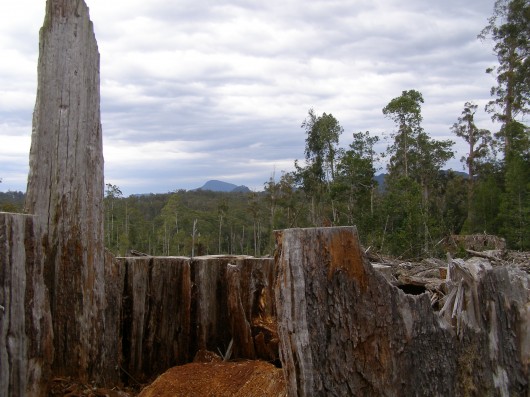 Forestry clearfell of old-growth in Tasmania’s Styx Valley
(Photo by Editor 20110928, free in public domain, click photo to enlarge) Forestry clearfell of old-growth in Tasmania’s Styx Valley
(Photo by Editor 20110928, free in public domain, click photo to enlarge)
.
More than two months (on 7th August 2011) after the landmark deal that promised to bring peace to Tasmania’s forests the protests – and the logging – continue unabated.
Funding for the struggling timber industry under the landmark $276 million Gillard-Giddings deal is starting to trickle out, but as yet not one tree has been saved!
Conservationists concede they may end up with nothing to show for 18 months of torturous negotiations, while many in the industry are sceptical that the promised peace will ever be achieved. The key decisions – on how many and which forests will be saved – are bogged down in difficult detail and alleged recalcitrance. Tasmania’s upper house, meanwhile, is lining up to sink the legislation needed to create the new national parks and reserves.
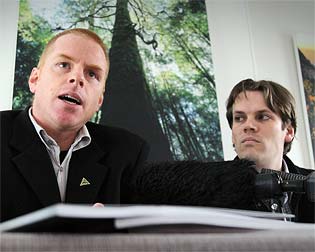 Environment Tasmania’s Phill Pullinger (right) with The Wilderness Society’s Vica Bayley Environment Tasmania’s Phill Pullinger (right) with The Wilderness Society’s Vica Bayley
.
A key conservationist and negotiator, Environment Tasmania director Phill Pullinger, concedes to Inquirer that events could conspire to see money flow to industry without one tree ever being saved.
“To be honest, it is a possibility,” says Pullinger, a Hobart doctor and former young Tasmanian of the year. “It has always been the case that the forest protection couldn’t be permanently delivered until the legislation goes through both houses of the Tasmanian parliament.”
.
That vote is a long way off, probably well into next year. The most immediate hurdle to overcome is a row over whether the state-owned Forestry Tasmania should be allowed to continue logging in 41 coupes (forest areas). All are within 430,000ha of forests set aside for “immediate” interim protection in the Gillard-Giddings deal of August 7, known as the Forests Intergovernmental Agreement or IGA.
Forestry Tasmania insists it needs to log in these coupes, a fraction of the total area, to maintain existing contracts to timber mills. Conservationists argue Forestry Tasmania could and should reschedule logging to less ecologically significant forests. The dispute was being sorted out by an independent rescheduling team appointed by state and federal governments. Inquirer has learned this process has gone badly for conservationists, with only seven of the 41 coupes able to be protected and five already logged. Forestry Tasmania and industry claim there simply is not time to do the rescheduling work – new roads, development of forest practices plans – necessary to shift to new areas quickly enough to meet existing timber contracts.
.
‘It is a fundamental problem that has weakened the (peace) process: you’ve got a government agency that is essentially working against the agreement. And the governments haven’t shown the stomach to pull the agency into line.’’
~ Phill Pullinger, Environment Tasmania, October 2011
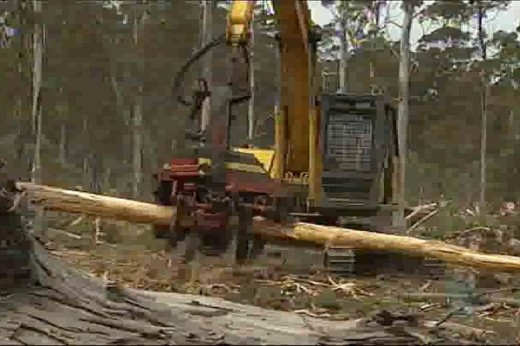
Conservationists claim this should have been done months ago, given that Forestry Tasmania was asked by the state government – its owner – to place a moratorium on logging in these forests in March.
“They (FT) have basically for 12 months now deliberately spun the wheels on that; there could easily have been a moratorium delivered six or nine months ago,” Pullinger says. “It is a fundamental problem that has weakened the (peace) process: you’ve got a government agency that is essentially working against the agreement. And the governments haven’t shown the stomach to pull the agency into line.”
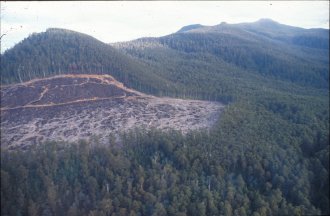
Crew-cutting pristine Tasmanian wilderness
.
This is rare intemperate talk from Pullinger, normally diplomatic and restrained as he tries to keep his constituency in the peace tent and the process on track.
It’s a sign things are not going well. Forestry Tasmania, a government business enterprise that reports to a board and is not necessary bound by ministerial direction, denies it has been dragging the chain. While it is the party with the most to lose – up to 572,000ha of native forest it manages for timber production – corporate relations manager Ken Jeffreys insists it is acting in good faith.
“Some people out there seem to think that FT has some maniacal glint in their eye and go out and harvest forests when it has no market because it has nothing better to do,” Jeffreys complains to Inquirer. “That is so far from common sense it’s hard to respond to.“
He insists Forestry Tasmania is happy to abide by the independent reschedulers’ verdict and points out that it has already rescheduled logging out of some contentious coupes. This fight over a handful of coupes has been holding up plans under the IGA for an overall immediate interim conservation agreement between the state, Forestry Tasmania and Canberra to protect the 430,000ha. Under the IGA, this interim agreement would protect those forests while an independent verification team determines the final size and location of the new permanent reserves.
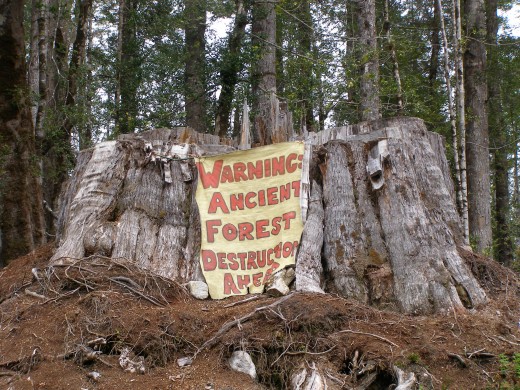 Ancient Myrtle Beech (Nothofagus cunninghamii)
chainsawed in the Upper Florentine Valley, Tasmania
(Photo by Editor 20110928, free in public domain, click photo to enlarge) Ancient Myrtle Beech (Nothofagus cunninghamii)
chainsawed in the Upper Florentine Valley, Tasmania
(Photo by Editor 20110928, free in public domain, click photo to enlarge)
.
IGA Independent Verification Team
.
The independent team, overseen by academic Jonathan West, will decide how much forest, of a larger 572,000ha nominated by green groups, is worthy of protection. West’s team will also test industry claims about how much timber it requires to meet existing contracts. Then it must decide how much forest can be protected while providing this resource. The job, which unrealistically is due to be completed by December 31, is the “forest wars” equivalent of deciding where exactly the boundaries of a Palestinian state should be drawn.
Conservation groups believe that most – if not all – of the 572,000ha can be protected, once a developing plantation resource is factored in.
.
Forestry Tasmania’s position
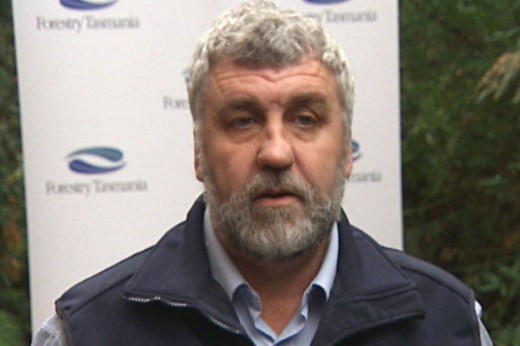
Forestry Tasmania chief, Bob Gordon
– what IGA? It’s logging business as usual to fill ‘orders’.
.
Forestry Tasmania stands by its modelling suggesting that no more than 300,000ha can be protected if it is to deliver on current timber contracts. Some in the industry believe only 250,000ha can be saved from the chainsaws. Neither of the industry figures is unlikely to be enough for conservationists, but may well be too much for Tasmania’s independent-dominated upper house. Several recent votes in the Legislative Council suggest it is opposed to the IGA and to more forest “lock-ups”. Its refusal to pass the reserves would leave conservationists relying on a federal-state conservation agreement to protect those forests.
While such an agreement would ban logging, it is legally uncertain if Forestry Tasmania could ignore this on the basis that it conflicts with its legislative or contractual obligations.
Jeffreys insists Forestry Tasmania would abide by any final agreement, subject to being able to meet those commitments – a big out if Forestry Tasmania decided to dig in for a battle.
.
Tony Burke’s position:
.
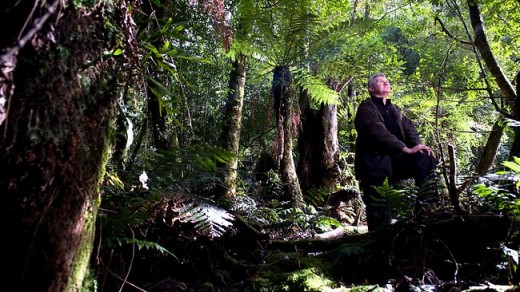 Federal Environment Minister Tony Burke
in Tasmania’s Wielangta forest, March 2011
(Photo by Matthew Newton, Source: The Australian ) Federal Environment Minister Tony Burke
in Tasmania’s Wielangta forest, March 2011
(Photo by Matthew Newton, Source: The Australian )
.
Despite the difficulties, federal Environment Minister Tony Burke remains confident he can pull off the kind of final “win-win” forest peace deal that has eluded so many of his predecessors. He tells Inquirer the alternative is a kind of mutually assured destruction, whereby the forests continue to fall as fast as the jobs.
The number of jobs in Tasmanian forestry has halved since 2008 from 6960 to 3460, due mainly to Japanese paper-makers boycotting woodchips sourced from native forests, Gunns exiting the industry in favour of a plantation-based pulp mill and as a result of the high Australian dollar.
“If you let the markets sort this one out without a co-ordinated strategy from state and federal government … then you end up with a terrible outcome for the Tassie economy … diabolical,” Burke says.
Initially as Forests minister and more recently as Environment Minister, Burke has been involved in the process from the beginning. The first in federal cabinet to twig to the potential to assist industry while securing a historic conservation outcome, he has repeatedly slipped quietly into Tasmania to do his own field work.
The former staffer to Graham Richardson has camped with greenies amid the giant eucalypts of the Styx Valley and toured sawmills and production forests. When the process has looked as if it were imploding, he has intervened with all sides to keep it on track. Inspired to join the ALP by landmark conservation battles such as the Daintree and Kakadu, Burke constantly stresses his desire to also secure a good outcome for jobs and industry.
He believes the (Tasmanian) Legislative Council will take a different view to new reserves when details are developed for a $120m federal regional development fund promised under the IGA. That money, to revitalise timber communities and diversify the Tasmanian economy, is contingent upon state parliament passing the new reserves legislation. No reserves; no $120m.
Burke, himself a former state upper house MP (in NSW), believes this cash for regions will ultimately win over the key 12 independent MLCs.
“Those MPs will have to look in the eyes of a whole lot of their constituents who are out of work and justify their actions,” he says. “I just don’t believe when it comes to it they’ll vote this down. This is the first time we have tried to deal with this issue with an independent process rather than a political fix. The irony this time is: can we stop politics from wrecking it, not from fixing it?”
He warns both sides will need to accept the outcome of the independent verification process. “They are honour-bound to accept the process – they created it,” he says.
This suggests Canberra will not be afraid to impose the verdict of the independent verification team if the two sides cannot embrace it – or at least an agreed variation of it. Such action may well see either side – timber or conservation – walk away.
Certainly, Pullinger won’t promise to accept the outcome if it is not embraced by both sides.
“If the independent verification group comes down and says … we are going to protect just a fraction of these forests … then – expert group or not – I don’t think anyone believes that is going to be able to deliver a lasting agreement.”
.
Editor:
The IGA deal is a deal is a promise. Why are Gillard and Giddings allowing Forestry Tasmania to renege on the deal by continuing to log these now protected native forests in Tasmania’s Styx Valley and southern forests. Why are Gillard and Giddings breaking their promise to Tasmanians?
IGA interim reserves are IGA interim reserves? The IGA offers millions in contractual compensation. So take the compensation Bob Gordon! You can’t have your compensation and interim reserves too!
Leave the bloody old growth alone!
 Prime Minister Julia Gillard, 2011
– do I really have to honour that forest deal?
(Photo: The Examiner) Prime Minister Julia Gillard, 2011
– do I really have to honour that forest deal?
(Photo: The Examiner)
.
Evidence of new logging despite Tasmanian Forests Agreement
.
[Source: ‘ Evidence of new logging despite Tasmanian Forests Intergovernmental Agreement requires urgent government action‘, by the Australian Conservation Foundation, 20110922, ^ http://www.thegreenpages.com.au/news/evidence-of-new-logging-despite-tasmanian-forests-intergovernmental-agreement-requires-urgent-government-action/]
.
Environment Tasmania, the Wilderness Society and the Australian Conservation Foundation have released a report assessing the status of logging in important native forests and photographs that show new logging activity in forest reserves prescribed by the Tasmanian Forests Intergovernmental Agreement (IGA).
“The settlement and retirement of Gunns’ native forest timber quotas has halved the demand for native forest timber from Forestry Tasmania, so there is no need or justification for logging within the forest reserve areas,” said Dr Phill Pullinger of Environment Tasmania.
“Wood supply for remaining sawmills can be provided from outside of the important native forests identified for protection,” Dr Pullinger said.
“Aerial photographs taken in late August and last week show Forestry Tasmania continues to log inside the 430,000 hectares of unique and important forests identified for immediate protection in the IGA,” said Vica Bayley of the Wilderness Society.
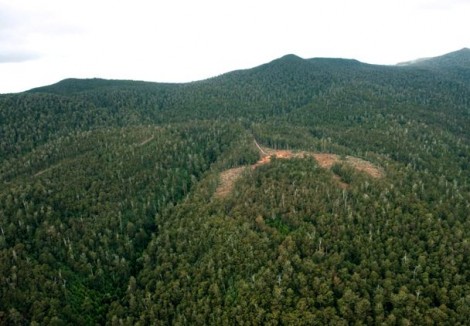
“In fact, our report and the new photos show Forestry Tasmania has not rescheduled logging outside this area and has even commenced logging new coupes since the IGA was signed.
“While we are encouraged to see progress on key components of the intergovernmental agreement — including the retirement of Gunns’ wood quota, funding for timber workers and contractors and the independent verification group — we have seen no progress on halting logging inside the nominated forest reserve areas,” Mr Bayley said.
“Environment groups again call on the state government to honour the agreement it has signed by directing Forestry Tasmania to declare the nominated forests as informal reserves and immediately appointing an independent expert to undertake the rescheduling,” said Denise Boyd of the Australian Conservation Foundation.
The report released today is part of environment group signatories’ ongoing commitment to implementing the IGA and will provide governments with verified, accurate information to help achieve the forest protection outcomes of the IGA. The state government must now ensure delivery of the critical plank of the IGA – forest protection.
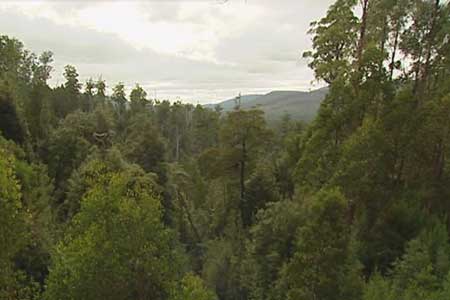
“We have seen no progress on halting logging inside the nominated forest reserve areas.”
~ Vica Bayley, The Wilderness Society
.
Forest protest continues in Mount Mueller Forest, Styx Valley (Tree Sit, Day 7)
.
Check out The ObserverTree protest website:
^http://observertree.org/

.
Tags: breaking promise, clearfell, Crew-cutting pristine Tasmanian wilderness, Environment Tasmania, Forestry Tasmania, IGA, interim reserves, Julia Gillard, Lara Giddings, Myrtle Beech, Nothofagus cunninghamii, Prime Minister Julia Gillard, Styx Forest, Styx Valley, Tasmania, Tasmanian Forests Intergovernmental Agreement, The ObserverTree, Tony Burke, Upper Florentine Valley
Posted in Tasmania (AU), Threats from Deforestation, Threats to Wild Tasmania | No Comments »
Add this post to Del.icio.us - Digg
Thursday, December 15th, 2011
“The moment one definitely commits oneself, then providence moves too. All sorts of things occur to help one that would never otherwise occurred. A whole stream of events issues from the decision, raising in one’s favor all manner of unforeseen incidents and meetings and material assistance which no man could have dreamed would have come his way. Whatever you can do or dream you can, begin it. Boldness has genius, power and magic in it. Begin it now.”
~ attributed to Goethe.
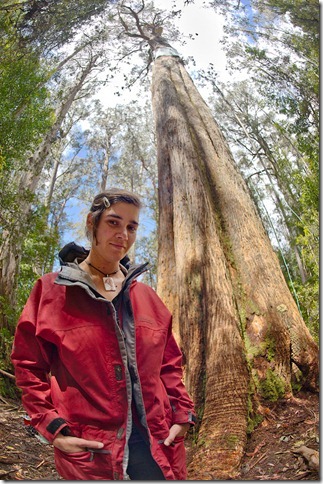 Miranda – Defender of Tasmania’s Forest Heritage
at the foot of ‘The Observer Tree‘
Mount Mueller Forest, Styx Valley, Tasmania
Miranda – Defender of Tasmania’s Forest Heritage
at the foot of ‘The Observer Tree‘
Mount Mueller Forest, Styx Valley, Tasmania
.
One young Tasmanian woman, charged with a deep commitment to her natural island heritage, continues to be prepared to do more to protect Tasmanian old growth forests than most Tasmanians. Miranda Gibson of Still Wild Still Threatened is certainly prepared to do more than the current (read ‘temporary‘) Premier of Tasmania Lara Giddings, and more than the current (read ‘temporary‘) Prime Minister of Australia, Julia Gillard, who have quickly turned their backs on Tasmanians to more populist party-political issues of the day.
.
 Tasmania’s Forest Wars
– what the Intergovernmental Agreement is supposed to resolve. Tasmania’s Forest Wars
– what the Intergovernmental Agreement is supposed to resolve.
.
Gillard and Giddings in breach of Tasmania’s 2011 Forest Agreement
.
Tasmanians are condemning government delinquency on meeting the conservation goals contained in the Gillard Labor Government’s Forests Intergovernmental Agreement (IGA) signed and promised to all Tasmanians in Launceston on 7th August 2011.
 Giddings and Gillard
– hollow Labor promises Giddings and Gillard
– hollow Labor promises
.
IGA Clause 25 states:
.
‘The State will immediately place the 430,000 ha of native forest identified in Attachment A (other than any areas which are not State forest) from the 572,000 ha nominated by ENGOs through the Statement of Principles process, into Informal Reserves.’
.
IGA Clause 27 states:
.
‘In the event that Forestry Tasmania reports that it cannot meet contractual requirements from production resources outside the nominated 430,000 ha the Governments will undertake the following steps. First, an independent expert will be jointly appointed by the Governments to review scheduling and other relevant data and attempt to reschedule harvesting activities so as to meet the requirements of contracts and maintain the interim protection of 430,000 ha. In the event that the independent expert concludes it is impossible to achieve this, the Commonwealth will compensate the contract holder for the value of lost profits and unavoidable costs.’
.
Gillard’s fly-in to Launceston on 7th August 2011 to sign and celebrate the Tasmanian Forests Intergovernmental Agreement with Labor mate Giddings was not a mere plaque unveiling, it was a Tasmanian landmark agreement to provide certainty for Tasmania’s forestry industry, support local jobs and communities, and protect the state’s ancient forests. It deserves the respect of commitment and follow through on promise.
On the one hand it has funded Forestry and its associated families hundreds of millions and with a dignified exit from logging and transition to alternate trades. On the other hand Gillard’s Forest Agreement guarantees protection for Tasmania’s natural but threatened heritage – its most iconic ancient forests, immediately placing 430,000 hectares of iconic old growth native forest into informal reserve – the Styx, Upper Florentine, Huon, Picton and Weld Valleys and the Great Western Tiers, Tarkine and Wielangta.
.
Gillard’s promise made to the Australian people (Prime Minister Gillard’s official website):
.
‘These forests will not be accessed for harvest while verification takes place.‘.
Well, verification is still taking place. And Bill Kelty, who brokered the deal, seems to have run to the hills.
Such a landmark State-wide agreement that promises a ‘strong foundation‘ is hollow if the leadership waddles off to be distracted by other issue so the day, without the committed delegation of trusted lieutenants to see through on implementation. Predecessor PM Kevin Rudd failed classically on the implementation phase of his policy – insulation being his and Garrett’s multi-million dollar incompetent legacy.
“The Australian and Tasmanian governments are taking too long to implement the intergovernmental agreement. If they can get their act together to offer contractors exit packages then they can honour the conservation agreement as well.” Greens Senator Bob Brown has said. “Four months later not one hectare has been protected and Forestry Tasmania continues to fell these magnificent trees as fast as they can put the roads in. All up, more than 10km2 of our wild forests will be destroyed“, Greens Senator Brown said.
All political leaders, while dancing on mountains of power and influence, pragmatically realise that their time in office is temporary. Status quo is not a characteristic of modern democratic politics. What matters most in political careers is legacy. Australia’s current Prime Minister Julia Gillard is starting to stare that legacy in the face as she allows Premier Lara Giddings to breaking the $276 million promise by backing Forestry Tasmania’s current logging of the 430,000 hectares of old growth forest protected under the Gillard Government’s Agreement.
.
Tasmanian Betrayal
.
Gillard and Giddings have allowed Forestry Tasmania to log the protected 430,000 hectares, ignoring the prescribed compensation requirement. Gillard and Giddings have blatantly reneged on their core promise in the Agreement to cease logging and to protect these forests. Gillard and Giddings have betrayed the Tasmanian and Australian people. They have no mandate to stay in power. Their broken promises are to be their legacies.
.
“Those who cannot work with their hearts achieve but a hollow, half-hearted success that breeds bitterness all around”
~ Abdul Kalam, President of India (b.1931)
 Styx Valley Giants being massacred by State logger ‘Forestry Tasmania’ Styx Valley Giants being massacred by State logger ‘Forestry Tasmania’
.
Tasmania sells itself as ‘the natural state’. But there is a gap between rhetoric and reality as logging of old-growth forests continues – to international dismay.
“And they have these big logs, and you just know they are coming from old-growth forests…I don’t think I could take living there and seeing them every day knowing (the trees) are going mostly to woodchips.” ~ Larraine Herrick or Tumbarumba, Snowy Mountains, New South Wales.
But the Styx has been, and (is continuing) to be, logged by the timber industry in a state in which questions have been repeatedly raised about whether cronyism, corruption and deception underlie the management of forests. Only discovered in 2002, El Grande was a Eucalyptus regnans with a 19-metre circumference. Last autumn (2003), it was killed when a regeneration burn went wrong. Its demise helped fuel a midwinter protest that drew more than 2000 people to the Styx Valley. There, The Wilderness Society and Greenpeace began a tree-sit, 65 metres up a threatened giant eucalypt called Gandalf Staff.
.
[Source: ‘Tasmania: seeing the wood but not the trees‘, by Melissa Fyfe and Andrew Darby, The Age Newspaper, 20040313, ^http://www.theage.com.au/news/science/tasmania-seeing-the-wood-but-not-the-trees/2004/03/13/1078594604573.html]
.
 ‘El Grande’
Australia’s largest tree burned to death in 2003 by Forestry Tasmania’s incompetence ‘El Grande’
Australia’s largest tree burned to death in 2003 by Forestry Tasmania’s incompetence
.
Tasmanian forests activist organisation Still Wild Still Threatened have called on the Federal and State governments to honour a $276 million forest deal made on 7th August 2011.
“This deal has already seen $35 million delivered to Forestry Tasmania and Gunns Ltd. without protecting a single tree” said Still Wild Still Threatened spokesperson Ali Alishah.
“It is clear that by backing Forestry Tasmania’s destructive practices within the identified 430,000 ha area of high conservation value native forest, the State and Federal Governments are in direct violation of Clauses 25 and 27 of their own Inter Governmental Agreement.” said Mr. Alishah.
.
.
.
The Observer Tree

Miranda Gibson on top of The Observer Tree
Totally committed to Tasmanian Forests,
unlike Gillard and Giddings hollow words.
.
Still Wild Still Threatened have this week launched a new tool in the fight to protect Tasmania’s forests today, unveiling the ‘ObserverTree‘, a 17-storey high tree sit and media centre equipped with the technology to record footage of logging operations and stream these images live to the world via the internet.
The Observer Tree is located in the Styx Forest below Mt Mueller, in Tasmania’s western wilderness, part of the 430,000 ha of forest that was supposed to receive immediate protection under the federal-state agreement on forests (the IGA). The Observer Tree is situated at the head of a section of Styx Forest currently targeted for logging by Forestry Tasmania.
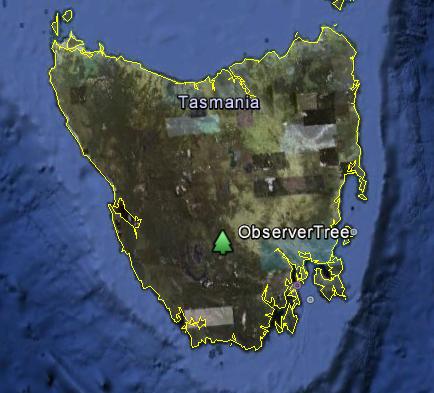 ‘Observer Tree’ location
^http://observertree.org/2011/12/15/observertree-on-google-maps/
‘Observer Tree’ location
^http://observertree.org/2011/12/15/observertree-on-google-maps/
.
Teacher, author and forest activist, Miranda Gibson, has vowed to occupy the tree-platform continuously, until real protection is secured for Tasmania’s forests. Ms Gibson will maintain a daily blog and upload video updates during her stay in the tree, documenting the struggle to protect Tasmania’s forests to concerned people all over the globe.
‘We have used the internet to connect this spectacular patch of threatened Tasmanian forest to the world. The Observer Tree will transmit images and information about the value of the thousands of hectares of forest that remain threatened if Julia Gillard does not keep her word. People across Australia and the globe will have the opportunity to view bear witness to the wasteful destruction of these forests and hear from the people fighting to protect them,’ said Ms Gibson.
For the first time their actual logging will be broadcast live internationally via the web.
Website: ^http://www.observertree.org
Facebook: ^http://www.facebook.com/#!/pages/ObserverTree/152795598158969
Download Google Earth (93MB): GoTo: ^http://www.google.com/earth/download/ge/
.
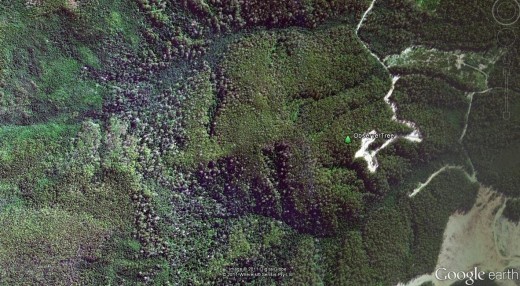 Google Earth’s satellite image of the Observer Tree in dense old-growth, adjacent to Forestry Tasmania’s fresh logging road
(click photo to enlarge) Google Earth’s satellite image of the Observer Tree in dense old-growth, adjacent to Forestry Tasmania’s fresh logging road
(click photo to enlarge)
.
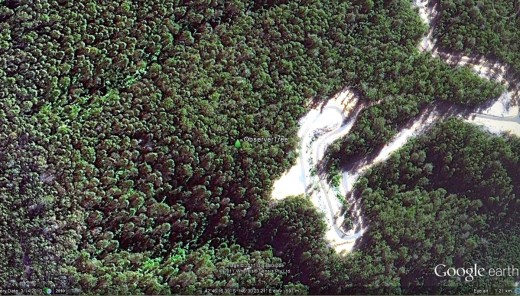 Close up image
(click photo to enlarge) Close up image
(click photo to enlarge)
.
.
Monday: Forestry Tasmania attacks the Styx Forest
.
On Monday 12th December 2011, State forest ‘nazi logger’, Forestry Tasmania, under the command of District Officer (Gauführer) Steve Whitely, rolled in its contracted ‘ecodeath-squad’ into the western end of the magnificent Styx Valley. The targeted forest area is situated at the base of Tasmania’s prominent and wild Mt Mueller on the border of the World Heritage Area. It is situated about 25 km west of the infamous logging town of Maydena.
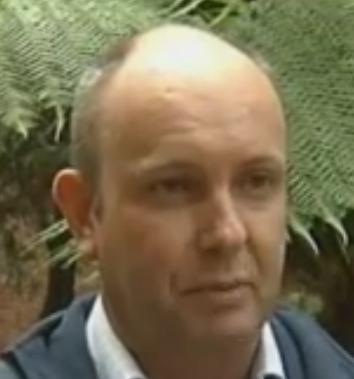 Directing the logging – Forestry Tasmania’s Steve Whiteley
[Source: Southern Cross Television, 20111214]
Directing the logging – Forestry Tasmania’s Steve Whiteley
[Source: Southern Cross Television, 20111214]
.
In true forest nazi style, Forestry Tasmania’s targeted forest area is branded as coupe ‘TN 044B‘.
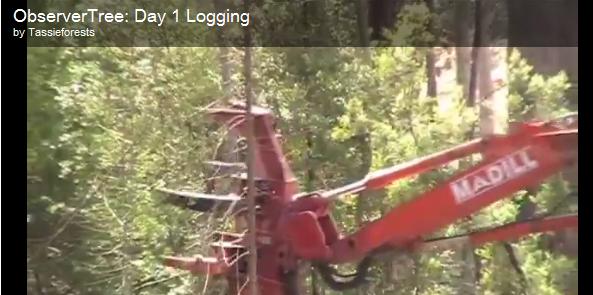 Logging Nazi in and destroying the Styx Valley Forest
Monday 12th December 2011, in direct breach of Prime Minister Gillard’s Forest Agreement. Logging Nazi in and destroying the Styx Valley Forest
Monday 12th December 2011, in direct breach of Prime Minister Gillard’s Forest Agreement.
.
This ‘Madill’ feller buncher was getting well stuck into the Styx Valley last Monday morning just below the Observer Tree. The hydraulic arm clamps onto the trunk of the tree while a cutting mechanism severs the tree at the stump. The machine then lifts the tree, lowers the tree into a horizontal position, and drops the tree on a bunch of logs piled on the ground. The industrial machinery has all the efficiency of a Nazi death factory.
.
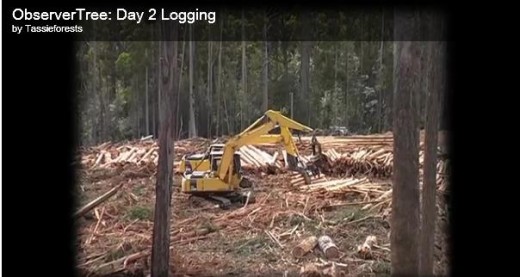
.
Foresty Tasmania is operating in direct contradiction of IGA Clauses 25 and 27. The coupes within the 430,000 ha of high conservation value forest are not to be logged under any condition. The IGA prescribes that relevant customers and contractors are to be granted compensation and million have been set aside for this purpose. Foresty Tasmania under Gauführer Steve Whitely is out of control. He is driving ecological apocalypse in Tasmania’s southern forests. He has become a Walter E. Kurtz.
 Walter E. Kurtz – unhinged, his methods unsound. Walter E. Kurtz – unhinged, his methods unsound.
.
Tags: Abdul Kalam, activist, Bill Kelty, El Grande, Forestry Tasmania, Gandalf, Google Earth, Inter Governmental Agreement, Julia Gillard, Lara Giddings, Maydena, Mount Mueller, nazi logger, Observer Tree, old growth forest, Still Wild Still Threatened, Styx Forest, Styx Valley, Tasmania, Tasmanian Betrayal, Tasmanian Forests Intergovernmental Agreement, The Observer Tree, Woodchipping Tasmania
Posted in Tasmania (AU), Threats from Deforestation, Threats from Weak Environmental Laws, Threats to Wild Tasmania | No Comments »
Add this post to Del.icio.us - Digg
Sunday, October 30th, 2011
The following article is a selected summary of relevant information sourced from the Tasmania Times (TT) online newspaper from articles and reader comments (October 2011) concerning the revelation that Tasmanian Premier Lara Giddings unnecessarily paid $34.5 million of taxpayers money to industrial logger Gunns as compensation for it exiting native forestry.
 Tasmanian Premier Lara Giddings (2011- )
What will be her legacy ~ accountable and faithful to the people of Tasmania? Tasmanian Premier Lara Giddings (2011- )
What will be her legacy ~ accountable and faithful to the people of Tasmania?
.
The Charge:
.
Previously secret communications between Gunns and Forestry Tasmania, obtained by the Liberals under Right to Information laws, blows a massive hole in (Tasmanian Labor Premier) Lara Giddings’ claim that she had no option but to pay Gunns’ $34.5 million in compensation for exiting native forestry. (NOTE: The $34.5 million = 23m for Gunns residual rights and $11.5m to settle the dispute with FT.)
A letter, dated 18 April 2011, from Gunns Chairman Chris Newman, to Forestry Tasmania Chairman Adrian Kloeden, reveals that Gunns not only wrote to Forestry Tasmania to formally terminate their native wood supply contracts (917 and 918) in April this year, they also offered to terminate the contracts on a “full release and indemnity basis.”
In part, the letter reads: “Gunns therefore wishes to terminate CoS 917 and 918…To the extent that FT requires formal notice, please treat this letter as notice of termination under clauses 3.3(b)(i) of Cos917 and 3.3(b)(ii) of CoS918.
.
“While Gunns remains ready, willing and able to perform its contractual obligations under CoS 917 and 918 during the notice period, we consider than an immediate separation would be in the interests of Gunns, FT and the Tasmanian forestry industry generally…“I therefore propose CoS 917 and 918 be terminated on a full release and indemnity basis in respect of any and all outstanding issues.”
.
Mr Newman also offered to help Forestry Tasmania gain access into the (immoral and greedy) Chinese Woodchip Market, including introducing FT to Gunns’ customers and also offered to hand over roading infrastructure to the value of $200 million over to Forestry Tasmania.
 Asian appetite for woodchips cares squat about the forest source,
cares squat about the means.
Tasmanians understand: Asian corporate culture is single bottom line:
Personal ends justifying any eco-social means to maximise personal economic wealth! Asian appetite for woodchips cares squat about the forest source,
cares squat about the means.
Tasmanians understand: Asian corporate culture is single bottom line:
Personal ends justifying any eco-social means to maximise personal economic wealth!
.
.
A Tasmanian Case to Answer:
 Tasmania’s traditional Coat of Arms
‘Ubertas et Fidelitas’? …”fertility and faithfulness” Tasmania’s traditional Coat of Arms
‘Ubertas et Fidelitas’? …”fertility and faithfulness”
.
The significance of this letter cannot be under-estimated. Under the hand of Gunns’ chairman, Gunns voluntarily wrote to Forestry Tasmania to terminate its contracts ‘immediately’ on the 18th of April 2011 requesting an ‘immediate separation’ which clearly would have extinguished the Premier’s so-called “residual rights”.
This is supported by the advice of Forestry Tasmania Managing Director Bob Gordon In a subsequent Ministerial Brief dated 10 May 2011 from to Bryan Green, where Mr Gordon informs the Minister that this offer to terminate on a “full release and indemnity basis” from Gunns would “extinguish” the need to negotiate in good faith new terms of agreement for supply, the so-called “residual rights” that Ms Giddings has claimed as the reason for the $34.5 million in compensation.
.
Given this correspondence, it appears inconceivable that Lara Giddings could have been advised by the Solicitor-General that the Government was obliged to pay Gunns to extinguish the contracts. Ms Giddings now has no option but to release the Solicitor-General’s advice on the matter.
Tasmania’s Resources Minister has played down correspondence between Gunns and Forestry Tasmania, which the Opposition says raises questions about Gunns’ right to government compensation for pulling out of state forests. The Opposition obtained a letter between Gunns and FT under Freedom of Information Laws, which shows Gunns offered to terminate its contracts. Liberal spokesman Peter Gutwein says it contradicts the Premier’s argument, that she had no choice but to pay Gunns.
“The Premier now has no leg to stand on,” he said.
.
.
Community insights and informed analysis:
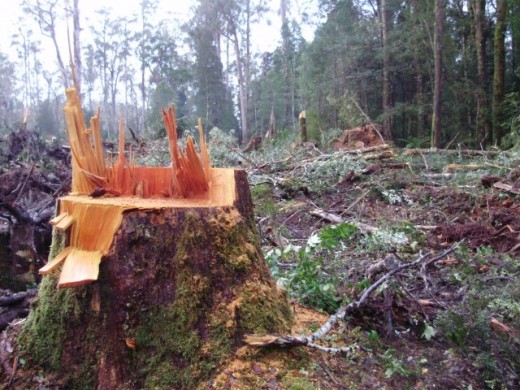
‘If all the above is genuine, and I can see no reason why it should not be, then the matter needs to be taken further. Much further. Lara and her “advisers” need to peruse all correspondence, memoranda and diary notes etc from Gunns in relation to their claim as to why there should be a payment to them by the taxpayers. Should there be a deliberate deception, or a deception by deliberate ommission that resulted in a serious financial advantage to Gunns then all avenues of recourse should be explored. If criminal charges are appropriate then so be it. It all would depend on the nature of the claims/submissions put forward by Gunns. There should also be cross referencing with any correspondence on the matter by Forest Tasmania. A formal investigation is surely warranted and the reason for the indecent haste in coughing up the taxpayer’s hard earned to Gunns and FT needs now to be justified.
Oh Lara. What a patsy you are. Your only contributions to the negotiations in this “complex” matter were to first publicly announce that “…we need Gunns..”, and secondly to publicly announce that you had $45 million in the “envelope” to resolve the “complex” matter. Brilliant. Just brilliant Lara.’
~ Len Fulton (a Tasmanian commenting to TT) 20111003
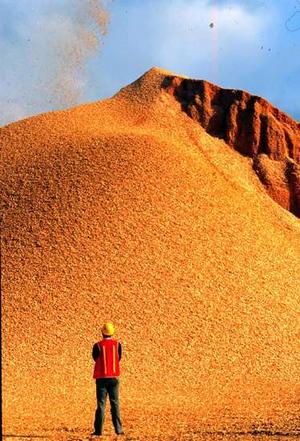
Woodchip stockpile – same colour as the chainsawed ancient Myrtle above
.
‘Very interesting documents. Regardless of whether you support the pulp mill or not there is something extremely fishy about this payment to gunns and all australian taxpayers should be screaming for the tabling for scrutiny of all documentation regarding the justification of this payment. Just on these produced documents and the fact that gunns had already closed down x no. of mills dismissed employees and placed triabunna on an approx. 8 week closure at the time the payment of compensation was dubious let alone some $34mil for the remaining life of the contract/s. This has a bad smell about it – now this previously “keep quiet” info is out Mr Gutwein what are you going to do about it?’
~ Ian (a Tasmanian commenting to TT) 20111003
.
‘Liberal complacence has helped foster the culture that has allowed our government to use excuses like “commercial in confidence” to not keep the public informed. So while Peter Gutwein is bouncing up and down on this issue, will he actually do anything, or remain as noticeable as a fly on the backside of an elephant?
~ Salamander (a Tasmanian commenting to TT) 20111003
.
‘Very revealing letter. I’ve previously argued that, if required, the Government should be prepared to buy back Gunns timber rights. Now, it seems, there was no need to buy them back at all because they had already formally relinquished them. This sheds a very nasty light on the way the Government rushed to pay Gunns double the initial offer. It also brings up questions about the $25 million that FT were apparently owned and why the Government felt it necessary to settle this matter to “avoid expensive legal arguments”.
The expense argument always seemed spurious. When there’s $25 million in dispute, surely it’s worth thrashing the matter out in court? On the other hand, the trouble with courts is that all the facts are likely to come out. I bet the Greens are having some interesting discussions at the moment! On the one hand there’s nothing to be gained by pulling the pin on Lala, but on the other hand, how far can they afford to let their reputation be trashed before they’ll never be able to recover the ground lost?’
~ Steve (a Tasmanian commenting to TT) 20111003

‘So Mr Gutwein, what are you going to do about it?
Are you quite rightly going to demand the return of all the ill-gotten monies from Gunns Ltd and Forestry Tasmania? Are you also going to demand FT collects monies owed by Gunns Ltd to them? Are you going to demand all the IGA (Julia Gillard’s Intergoverment Agreement) monies be shared amongst everyone except these two companies as was intended?’
~ Russell Langfield (a Tasmanian commenting to TT) 20111003
.
‘This isn’t the first or the biggest apparent fraud Tasmania has seen – the land swap was far bigger and the pulp mill approval business was more blatant – but it’s still very unusual to see the LibLabs falling out on something like this. The Tas justice system was magnificent in snatching Bryan Green from disaster, but do they have they the moxie to save the government’s bacon here? I suspect that Tas Inc’s closets are too dank to support an explosion, but I hope I’m wrong.’
~ John Hayward (a Tasmanian commenting to TT) 20111003
.
‘These damning documents show that the potential financial scam perpetrated upon the Australian and Tasmanian taxpayer is even worse than that stated by Peter Gutwein. Firstly, a further 10% GST has been added to the payments made to Gunns and FT increasing the amount paid in so-called settlement to $37.95M. On top of that, FT has effectively written off the $13.5M balance of the $25 million reputedly owed to it by Gunns under the ‘take or pay‘ provisions of its wood supply contracts bringing the total amount gifted by the taxpayer to at least $51.45 million.
Tasmanians must be told why, and on whose advice, was Gunns’ termination offer made on 18 April 2011 not accepted by FT and what part did the Premier and her Deputy play in this? What was the role of the Solicitor General and what were the circumstances that led to the Premier claiming the need for payment to extinguish Gunns’ “residual rights”?
What is the legal precedence and basis for the taxpayer settling a financial dispute between a private company and GBE over which the Minister has limited jurisdiction and no apparent financial control? The scale of this matter is beyond the scope of the feeble Integrity Commission and is so serious that it demands a full criminal investigation.
Finally, given that the release of this documentation has the potential to bring down the Government, the motives of the usually recalcitrant FT for being so forthcoming to the Shadow Minister for Forestry’s request are extremely suspect and demand that FT is put into administration pending the outcome of investigations.’
~ PB (a Tasmanian commenting to TT) 20111003
.
‘As per Chris Newman, Gunns ….“I will not recount Gunns’ various complaints of defective performance and non-performance by FT ….” Why? Not consistent with Gunns previously pretending the woodchip driven industry was sustainable let alone ‘worlds best practice’! Can the public see a copy of those complaints? Surely they are not all ‘commercial in confidence’.
“The reputation and marketability of Tasmanian native forest woodchip product is, and has always been directly affected by FT’s forestry management practices …” You forgot to add … and Gunns greedy easy street deal to woodchip bio diverse forests into oblivion. “FT was aware of the damage that its forestry practices were causing to the reputation of Tasmanian woodchip products …” Oh so FT’s forestry practices haven’t been a beautiful shining example afterall … I’m shocked at having been so deceived!! “Gunns therefore wishes to terminate CoS 917 and 918, noting our agreement that construction of the pulp mill did not commence by 30 November 2010.” You mean Gunns deliberately didn’t make a commencement of the mill to get out of the contract or used the companys own incompetence and failure to grab a government payout?
“Ünless a commercial resolution can be reached, I fear that these disputes will ultimately result in court proceedings.” Is that called holding the state to ransom … or bribery perhaps?
“I therefore propose that CoS 917 and 918 be terminated immediately on a full release and indemnity basis in respect of any and all outstanding issues.” So that’s what Gunns meant as per their ASX market update.
“3. Mutual release between the company and Forestry Tasmania from certain current and future claims arising out of those agreements.” “At the same time, FT will receive the benefit of a substantial infrastructure, worth in excess of $200 million, established by Gunns in anticipation of harvesting pulpwood from State Forests pursuant to CoS 917 and 918.” Is that where the touted $200 million figure for the so-called locking up of native forests originally came from? And you mean to say those native state forests being established, (albeit in reality little more than plantations) after wiping out the original diverse forests, weren’t actually being grown for future sawlogs, but indeed for nothing but pulpwood … thought so!
Bobby Gordon to embattled Bryan Green …. “It is unlikely the exchange of letters between Gunns and FT will become public.” … Why, something to hide perhaps? Obviously Labors Braddon office shredder mustn’t have been available.
“In the event that stakeholders become aware of the termination notice, Forestry Tasmania intends to release the following statement….” Is that called conspiring?
Let’s call it as it is, the $23 million for ‘residual rights’ and the Labor Gov gifting Gunns $11.5m to virtually pay itself via FT wasn’t to buy back HCV state native forests, it was hush money! Gunns are undoubtedly as successful as a trap door in a canoe. Gunns would be better off to start manufacturing butchers chopping blocks on wheels which they could pass around to their shareholders, directors, contractors, workers and political allies. Afterall, apparently they are attributing any future succusses on continuing to mobilize a self-serving carvery …
 Citizens’ justice – doing away with privilege, the French way
[Source: http://www.toonpool.com/user/589/files/it_chops_383035.jpg] Citizens’ justice – doing away with privilege, the French way
[Source: http://www.toonpool.com/user/589/files/it_chops_383035.jpg]
.
Caught in an avalanche of their own making, Gunns have at least successfully pulped themselves …Gunns and Forestry Tasmania and indeed blokes like Bryan Green and the Tasmanian Labor Government have been treating the public like fools for far too long … just desserts is the same ridicule and contempt they have shown the state of Tasmania.’
~ Claire Gilmour (a Tasmanian commenting to TT) 20111003
.
‘Other than the pyrotechnic display contained in this letter there are other incendiary devices. Such as the Gunns Chairman admitting that “construction of the pulp mill did not commence by 30 November 2010” That’s very different from the findings of EPA director Schaap. There is also a clear accusation that FT abused its monopoly position in the Tasmanian pulp wood market.’
~ Karl Stevens (a Tasmanian commenting to TT) 20111003
.
‘Has Gutwein called the Federal Police? If not, why not?
His inference is that The Commonwealth, and the State of Tasmania has been defrauded and if so it is very difficult to see how the Premier and Prime Minister are not parties to the act. In the absense of that call to the police being made, Mr Gutwein is nothing but another useless mouth we are feeding for no discernable benefit. Time to piss, Peter, or get off the bloody pot.If you don’t, many of us will return to our default position which is that we are governed by a coalition of liblab with the greens used as a smoke screen.’
‘Your party’s voting record backs that view to the hilt.. On reflection I would go further: Either it is fraud and therefore conspiracy to commit fraud, or it is extortion. Either way, it has all the hallmarks of something the federal police should be investigating. Why the Feds? Aside from the obvious reason it is federal money involved. My bet is that Gutwein will do nothing substantial because the bottom line is the Libs are run by TasInc who want the mill built right or wrong by anyone because they can make a dollar out of it. They fund both wings of the liblab machine. Such is the nature of party representatives. They know what the voters want, but serve the party interests first because that is where their loyalty lies. You get what you vote for. That gaping hole in the mills risk profile has not and will not go away regardless of any of this. It just keeps getting larger.’
~ Simon Warriner (a Tasmanian commenting to TT) 20111004
.
‘Having also read all the FOI it is interesting to see that Gunns had already terminated the wood supply agreements and that after the 15th of October the agreements were finalised. Also the $200 million of roading and bridge assets that they told FT they would be giving them would have reverted to FT ownership after 45 days under the agreement anyway. It appears that the rush to give Gunns money was important because after the 25 th October there would have been no reason to pay them anything. The briefing docs to Bryan Green show that he was fully cognisant of the deal ending.’
~ Pete Godfrey (a Tasmanian commenting to TT) 20111004
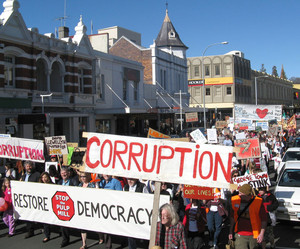
.
.
.
Subsequent revelations…
.
‘No advice on $34.5m Gunns deal: Tony Burke’
.
[Source: Matthew Denholm, Tasmania correspondent, The Australian, 20111022, ^http://www.theaustralian.com.au/news/nation/no-advice-on-345m-gunns-deal-tony-burke/story-e6frg6nf-1226173569723]
.
Federal taxpayers paid $34.5 million to Gunns to extinguish its rights to log Tasmania’s native forests without Canberra first seeking advice on whether the payment was legally required. Federal Environment Minister Tony Burke told The Weekend Australian he had not sought legal advice on whether the payments were necessary to extinguish Gunns’ contractual rights.
“I didn’t seek any advice on that,” Mr Burke said. “Legal advice on that was sought by the Tasmanian government.”
The state Liberals claim the payment was not legally required because Gunns had already voluntarily handed back the contracts to harvest 210,000 cubic metres of sawlogs each year. Tasmania’s Labor-Green government, which brokered the payment to Gunns, is refusing to release its own legal advice on the issue. However, Premier Lara Giddings insists the advice backs its stance that the payment was needed to remove Gunns’ “residual rights” over the vital contracts.
Their surrender was key to the protection of 430,000 hectares of forests under the $276 million federal-state forest peace deal signed by (Prime Minister) Julia Gillard in August (2011). However, Gunns had said it was leaving native forest logging regardless and documents obtained by the Liberals under state right-to-information laws show that on April 18 the company gave “formal . . . notice of termination” of the contracts.
Despite this, on September 15 deeds signed by the Tasmanian government granted $23 million in funds provided by Canberra to Gunns and a further $11.5 million—also federally sourced—to Forestry Tasmania. Mr Burke said yesterday the money had been provided to the Tasmanian government to “facilitate” the peace deal, also known as the Intergovernmental Agreement on Forests. Late yesterday, federal Agriculture Minister Joe Ludwig and Tasmanian Deputy Premier Bryan Green announced an additional$45 million voluntary exit package for Tasmanian forestry contractors. “This package will assist eligible contractor businesses to exit the native forest harvest, haulage and silvicultural contracting sectors,” he said.
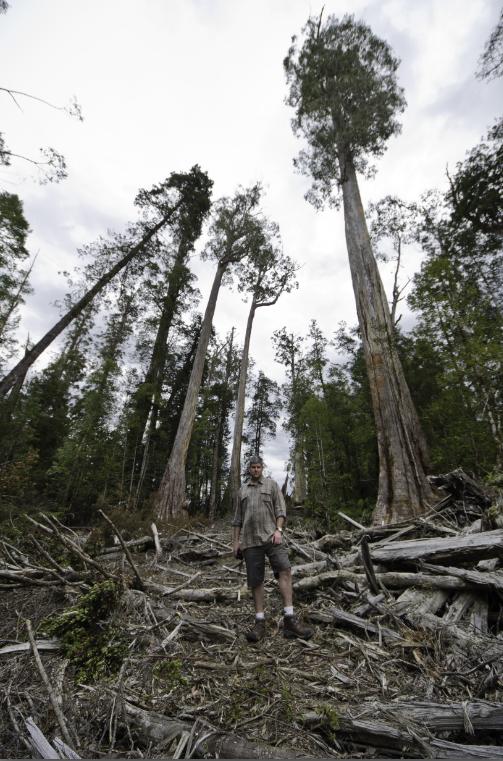 Meanwhile, Forestry Tasmania continues in earnest its wholesale massacre and incineration
of Tasmanian Old Growth for woodchipping pittance
(Upper Florentine Forest old growth, photo taken 28th September 2011) Meanwhile, Forestry Tasmania continues in earnest its wholesale massacre and incineration
of Tasmanian Old Growth for woodchipping pittance
(Upper Florentine Forest old growth, photo taken 28th September 2011)
.
.
‘Minister dodging questions on Forestry handout. Mill buyers. Gunns quizzed’
.
[by Kim Booth MP Greens Forestry spokesperson MR, 20111019, ^http://tasmaniantimes.com/index.php?/weblog/article/minister-dodging-questions-on-latest-forestry-handout/]
.
The Tasmanian Greens today said the Forestry Minister Bryan Green has failed to explain to the Tasmanian people why he approved another $1.1 million in public funding to prop up the failing forestry industry. Greens Forestry spokesman Kim Booth said there’s no credibility to the Minister’s claim that the industry could afford the transportation costs to Triabunna, but somehow could not afford to go the remaining 146 kilometres to Bell Bay without receiving public subsidisation.
.
“If the woodchipping industry is so unviable that it cannot even afford to pay the cost of transporting logs 146 kilometres, it is about time that the Minister realised that the industry is just not viable,” Mr Booth said.
“The Minister must first justify then explain why he thinks woodchippers of native forests should be paid with public funds and should take priority at a time when other areas are having to do it tough by cutting services.”
“As for the question of the supposed ‘log jam,’ the question must be asked why Forestry Tasmania is causing these trees to be cut down if the operators cannot even afford to transport them to the point of sale?”
“Every other transport business in the state must survive on its own resources, and there’s no doubt that all the other struggling transport operators in Tasmania would love a handout. So why is the woodchipping industry treated so differently?”
“How many million dollars of public money will this Minister rob from the public purse and give to his industry darlings before he wakes up to the fact that public money if for public benefits like healthcare, not to prop up unviable private businesses.”
 ..The Tasmanian Government’s logo…’explore the possibilities’…at what cost?
A return to Tasmania’s traditional coat of arms would be very appropriate. ..The Tasmanian Government’s logo…’explore the possibilities’…at what cost?
A return to Tasmania’s traditional coat of arms would be very appropriate.
.
.
Further Reading:
.
[1] ‘ Explosive letter confirms Gunns voluntarily gave up contracts‘, Tasmanian Times, 20111005, ^ http://tasmaniantimes.com/index.php?/weblog/article/explosive-letter-confirms-gunns-voluntarily-gave-up-contracts/
[2] ‘ More questions over Gunns’ rights buyout‘, 20111003, ^ http://www.abc.net.au/news/2011-10-04/2011041011-gunns-rights-buyout-questioned/3207848?section=tas
[3] Letter from Mr Newman and subsequent Ministerial Brief: Gunns_letter_and_Ministerial_briefing.pdf [ Read Letter]
[4] The full Right to Information documents requested by Peter Gutwein MP, Forestry Tasmania, ( Part 1), ( Part 2)
[5} ‘ Hush Lara Hush‘, by Peter Henning, Tasmanian Times, 20110520, ^ http://tasmaniantimes.com/index.php?/weblog/article/hush-lara-hush/
•
.
Tags: asian corporate culture, commercial in confidence, corruption in confidence, Forestry Tasmania, Gunns, Gunns' residual rights, Julia Gillard, Lalaland, Mr Greedy, Peter Gutwein MP, Right to Information, Tasmanian Forests Intergovernmental Agreement, Tasmanian Solicitor General, The Lala Swindle, Ubertas et Fidelitas
Posted in Tasmania (AU), Threats from Deforestation, Threats from Greenwashing, Threats to Wild Tasmania | No Comments »
Add this post to Del.icio.us - Digg
Friday, July 29th, 2011
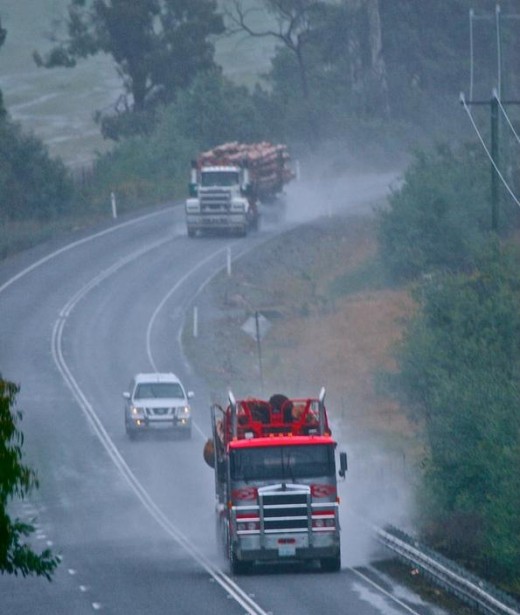 Trucks Logging Tasmania
© Photo by Paul Tapp, Triabunna, Tasmania, 20110718
[Source: http://tasmaniantimes.com/index.php/article/the-triabunna-experiment] Trucks Logging Tasmania
© Photo by Paul Tapp, Triabunna, Tasmania, 20110718
[Source: http://tasmaniantimes.com/index.php/article/the-triabunna-experiment]
.
‘A peace deal between Tasmania’s forestry industry and environmental lobby has been secured by a $274 million government package, raising hopes the long-running conflict is near an end.
.
‘The deal hammered out at the weekend by the Prime Minister, Julia Gillard, and the Tasmanian Premier, Lara Giddings, has the full backing of industry but was criticised by green groups.
The deal ensures existing major logging contracts can be met from forests outside the protected areas but halves the key sawlog quota. The package confirms the reservation of 430,000 hectares of native forest around the state, including the Tarkine rainforests of the island’s north-west and ‘a sprinkling of mountainous coastal forests around the east coast’.
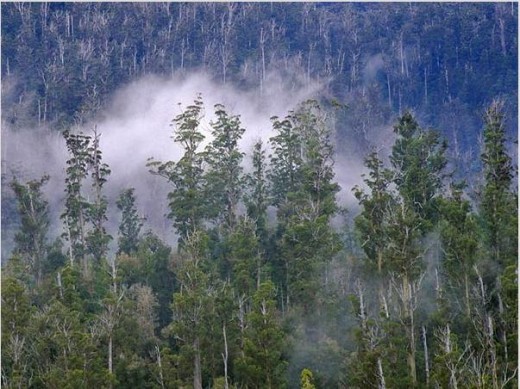
‘With the lion’s share of funds to come from the Commonwealth, the package’s big-ticket items are $85 million to workers and contractors who lose their jobs in industry restructuring, $120 million in extra regional development money for Tasmania and $43 million to implement the changes.
‘The strategically important Triabunna woodchip mill, bought by wealthy environmentalists Jan Cameron and Graeme Wood last week, is to keep operating. But its chips will need Forest Stewardship Council certification, meaning an end for the mass woodchipping of old growth that so divided Tasmania.
‘But one of the chief negotiators, Phill Pullinger of Environment Tasmania, said critical points still lay ahead in translating the weekend’s federal-state heads of agreement into a fully operational process.
‘The federal Greens leader, Bob Brown, said the agreement was a ”Labor-Labor-loggers‘‘ outcome.
”The popular expectation that a 610,000 hectare system of wild forest national parks would be established, as the loggers were bailed out of their failing industry, has been dashed.”
.
[Source: ‘ $274m buys hope that bitter logging dispute is at an end‘, by Andrew Darby, The Age newspaper, Hobart, 20110725]
Read more: ^http://www.theage.com.au/environment/conservation/tasmania-in-274m-forests-deal-20110724-1hves.html
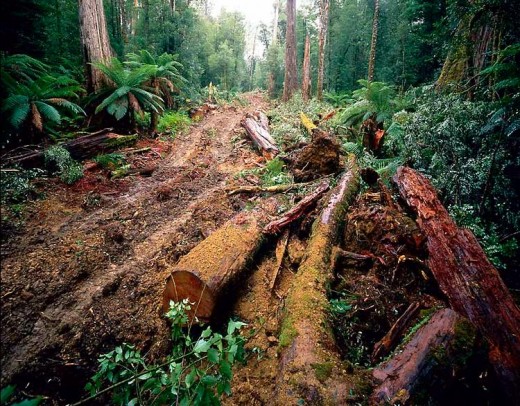 A Forestry Tasmania Footprint
© Photo by Rob Blakers Photography, www.RobBlakers.com A Forestry Tasmania Footprint
© Photo by Rob Blakers Photography, www.RobBlakers.com
http://www.water-sos.org/rob-blakers1.html
‘There has always been good reason to preserve Tasmania’s native old-growth forests. But two years ago the bitter, protracted conflict between loggers and conservationists took a decisive turn.
‘Scientists at the Australian National University revealed that the moist, cool forests of south-eastern Australia are the most carbon-dense environments in the natural world. They store on average more than twice the carbon per hectare than moist, tropical rainforests, which are a more familiar focus of global environmental concerns. Then in May this year, Australia’s new Climate Commission identified the preservation of these forests as critical in limiting Australia’s emissions “while the slower process of transforming energy and transport systems unfolds“.
‘Likewise, the commission estimated billions of tonnes of carbon could be sequestered from the atmosphere if logged areas were reafforested. Add to that the novel intervention of two entrepreneurs who recently paid $10 million for a Gunns sawmill – just so they could close it down – and it seems the three-decade-old impasse over Tasmania’s native forests has finally been broken.
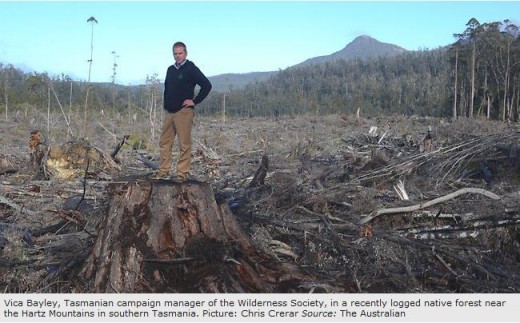
‘This weekend’s $274 million federal government package, which puts 430,000 hectares of native forests off-limits to loggers, is a historic first step. True, the deal between environmentalists and the timber industry is a compromise and not everyone is happy. But the agreement does recognise two crucial claims: the urgent need to protect native forests from further commercial encroachment and the legitimate demand for compensation from communities that have long lived from logging. Tasmania’s small regional economy is vulnerable, which is partly why logging, and the jobs it supports, have long been such a divisive issue. Equally, the dispute has been deadlocked for want of an alternative vision.
‘Globally, forest clearing is responsible for 18 per cent of greenhouse gas emissions. With a carbon tax coming in Australia and numerous carbon trading schemes already operating around the world, such extraordinary carbon sinks as Tasmania’s old-growth forests now have an economic value, not just an ecological one.
‘At the same time, the competitiveness of Tasmania’s woodchip industry has been declining because of the high Australian dollar and low-cost plantations elsewhere. Tasmania’s green credentials have been compromised by images of protesters chained to trunks and of magnificent, ancient trees being felled to satisfy the world’s appetite for woodchips, pulp and disposable chopsticks.
‘Australia’s smallest state should now be able to position itself favourably for the low-carbon economy of the future. That does not rule out supplying high-quality, high-value timber sourced from “certified sustainable” plantations to an environmentally discerning local and global market.’
.
[Source: ‘Old-growth valued at last‘, Sydney Morning Herald, Editorial, 20110725, p.10]
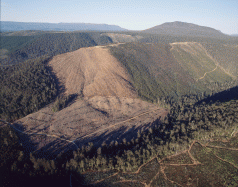 © Photo by Rob Blakers © Photo by Rob Blakers
.
.
Editor’s comment:
.
Government bail out of a 19th Century exploitative industry with taxpayer millions is expedient short term politics ~ throwing other people’s money at the problem. The Labor Gillard Government has just pitched a $274 million bail out package to Forestry Tasmania and its dependents, but as usual the devil is in the detail. That funding is stretched over ten years and is split between the Federal and Tasmanian governments. It seems only $85 million is being made available from Gillard’s bail out in the current year. Her press release (copy below) is unclear on this. Moreover, while $85 million is welcome to Tasmanians, at the same time as Premier Lara Giddings announced recently, Tasmania has been denied a total of around $1.5 billion in expected GST revenue and State taxes from the Federal Government. Tasmanian revenues are being controlled by Canberra. Canberra is treating Tasmania as a welfare state, and a welfare state is what Tasmania is becoming.
.
Twenty-first Century leadership for Tasmania requires triple-bottom line innovative problem solving, listening to all the people of Tasmania.
.
It is incumbent on Tasmanians themselves to strategise a long term competitive and independent vision for Tasmania’s economy and society that respects Tasmania’s natural values. Twenty-first Century political leadership would see the national government encourage this, facilitate a transition process (and not deny GST funding) to trust and enable the island elected Tasmanian Government itself to implement the transition strategies as it sees fit. The transition process demands a quantum investment in vocational education of Tasmanians. So where is that strategy?
.
The crux of Tasmania’s triple bottom line problem in all this is that ‘Tasmania’s small regional economy is vulnerable!’
.
Overhaul and nurture Tasmania’s regional employment to ‘certified sustainability’, since only then may Tasmania’s regional social and ecological systemic problems be resolved with broad community support.
.
In the editor’s view, Tasmania has sufficient natural resources, clean-green industries and innovative entrepreneurs to give New Zealand and its ‘pure’ brand image a run for its money. Tasmania’s natural and human capital just need to be tapped, nurtured and professionally marketed…globally.
.
The following extracts provide some background reading in this issue. Readers can make up their own minds.
.
.
Background Reading:
.
What is the Tasmanian Government’s strategy?
.
Start with the lead agency, termed the ‘Tasmanian Planning Commission’
.
Well it seems its strategy is mainly about urban development. “The current main strategic national priorities are:
- Capital city strategic planning
- Development assessment reform
- Housing affordability
- Climate change (however that is dealt with)
- Retail competition.”
.
What the hell is the Tasmanian Planning Commission’s terms of reference, or is there some other entity delegated to consider Tasmania’s ‘whole of island’ planning?
READ MORE: ^http://www.planning.tas.gov.au/the_planning_system/national_planning
.
.
…meanwhile…’Prime Minister’s press release on the future of ‘Tasmanian Forestry’, 20110724
.
‘Australian and Tasmanian Governments support the future of Tasmanian forestry‘, Sunday 20110724, jointly by the Prime Minister and Premier of Tasmania
[Source: ^http://www.pm.gov.au/press-office/australian-and-tasmanian-governments-support-future-tasmanian-forestry]
.
‘Prime Minister Julia Gillard and Tasmanian Premier Lara Giddings today announced an historic agreement on the future of forestry in Tasmania. In the face of changing market conditions, both in Australia and around the world, it has become clear that the pressure on the Tasmanian forestry industry in its current form is not sustainable. Today’s agreement will secure jobs, ensure a sustainable forestry industry, and achieve iconic environmental outcomes by protecting High Conservation Value forests and remaining old growth forests for future generations.The Heads of Agreement, backed by up to $276 million, will also support workers and their families affected by industry restructure.
Under the Heads of Agreement:
- The Australian and Tasmanian Governments will provide up to $85 million in immediate assistance for workers and contractors who are losing their jobs and livelihoods as a result of industry restructure. This will include employee assistance, retraining and relocation support and assistance for voluntary permanent exits from native forest operations for haulage and harvest contractors (what to?);
- Facilitate sustainable opportunities for the Tasmanian forestry sector with the Tasmanian Government guaranteeing at least 155,000 cubic metres per year in wood supply, 12,500 cubic metres per year of speciality timbers, subject to verification and 265,000 cubic metres of billets, with existing wood supply contracts to be honoured and the Australian Government to fund a voluntary exit mechanism to enable further native wood supply capacity to be retired and reserve areas increased when suitable plantation wood supply is available;
- The Tasmanian Government will reserve and protect 430,000 hectares of native forest from within the 572,000 hectares nominated through the Statement of Principles process, and place the full 572,000 in informal reserve subject to an independent verification process of conservation values and compatibility with yearly guaranteed wood supply, led by Professor Jonathan West. The findings will determine the area of High Conservation Value forest to be reserved, with $7 million a year for their ongoing management to be provided by the Australian Government following incorporation into formal reserves;
- $120 million in Australian Government investment over 15 years, including $20 million in 2011-12, to develop and diversify the Tasmanian economy to drive new job opportunities for Tasmanian families, including through job-creating projects (such as?) in communities affected by forestry restructure. A new ministerial advisory council to be chaired by Mr Bill Kelty AC will drive new regional development opportunities and a new place-based investment Memorandum of Understanding (MoU) between the two governments; and
- The Australian Government will provide $43 million to implement the Heads of Agreement including funding for a range of activities such as working with communities through the transition and provide voluntary compensable exits to sawmillers wishing to exit the native forestry industry.
.
The Heads of Agreement is consistent with the Statement of Principles agreement between environment non-government organisations, the Tasmanian forestry industry and the CFMEU, which was presented by independent facilitator Mr Bill Kelty last month.
It means the forestry industry can continue on a sustainable footing, and guarantees ongoing supply for existing businesses that are critical to supporting jobs and regional communities in Tasmania.The Australian and Tasmanian Governments thank the signatories to the Statement of Principles and Mr Kelty for their commitment and hard work. The Statement of Principles process and the Heads of Agreement reached today creates an opportunity to move forward after decades of conflict and build a stronger future for Tasmania.Governments recognise the significant challenges faced by the industry in the face of global economic and market conditions as well as the historic opportunity provided by forestry and environmental parties coming together to agree on a framework for delivering a sustainable future for the forest industry and the environment. We also recognise that these challenges, as well as the decision by Gunns Limited to exit from native forestry, will have significant impacts on workers, communities and the Tasmanian economy.The Governments clearly expect that following today’s historic agreement environment and industry stakeholders will end the long-running conflict over native forestry. The Governments also expect that the Tasmanian Parliament will pass the required legislation by 30 June 2012. The Australian and Tasmanian governments will work together to identify and support regional economic development through a partnership to create investment and jobs opportunities, particularly for regional communities..
The Australian and Tasmanian Governments will also work together to examine and identify potential opportunities from increased reserves from the Commonwealth Biodiversity Fund. In October last year, the Tasmanian forestry industry and several environmental non-government organisations reached a Statement of Principles for protecting native forests and developing a sustainable timber industry in Tasmania. The Australian and Tasmanian Governments appointed Mr Bill Kelty as an independent facilitator to facilitate talks on the Statement of Principles agreed to between environment non-government organisations, the CFMEU and the forestry industry in Tasmania.’
.
.
…meanwhile…’Independent Strategic Review of Forestry Must Examine Auditor-General’s Report’
by Kim Booth MP, Greens Member for BassKim Booth MP, Greens Forestry spokesperson, Wednesday, 20110706
[Source: ^http://mps.tas.greens.org.au/2011/07/independent-strategic-review-of-forestry-tasmania-must-examine-auditor-general%E2%80%99s-report-and-no-further-public-bail-out-without-parliaments-approval/]
.
‘The Tasmanian Greens today called on the Minister for Forests to ensure that the current independent Strategic Review into Forestry Tasmania includes the Auditor-General’s Special Report 100, Financial and economic performance of Forestry Tasmania, saying that the Report makes it clear that Forestry Tasmania is a failed business and in urgent need of restructure..
Greens Forestry spokesperson, Kim Booth MP, also called for a commitment that no further public monies will be used to bail out Forestry Tasmania from any financial difficulties without such a funding injection first coming before the Parliament.
“I have long been on the record warning the Minister that Forestry Tasmania is a rogue agency that has been unable to return a sustainable commercial rate of return for the Tasmanian public, and is in fact a drain upon the public purse,” Mr Booth said.
“As Shareholder Minister, it is incumbent on him to take responsibility for the fact that the Auditor General formed the view that whilst the ‘expectation of Forestry, and the environment in which it operates, changed fundamentally’ over the last 15 years, the ‘business and funding model did not keep pace with these changes.”
“This Report by the Auditor-General is relevant to the independent Strategic Review of Forestry Tasmania, and the Greens believe it must be formally submitted for the Review’s consideration.”
“With Forestry Tasmania crying poor and the suggestion that more public money might be required to pay their employees superannuation how will the Minister reassure Tasmanians that he will take a more active role in ensuring hard-earned public money is not thrown into the bottomless pit that is Forestry Tasmania?”
“Any further injection of public funds, to bail out this underperforming GBE, should not occur without first seeking Parliament’s approval of any conditions set upon which public money is provided,” Mr Booth said.’
.
.
…meanwhile…’What the community thinks of the forest peace talks’
Media release by Forestry Tasmania, 20110724.
[Source: ^http://www.forestrytas.com.au/news-room/media-releases/what-the-community-thinks-of-the-forest-peace-talks].‘Forestry Tasmania has this morning released a new opinion poll to provide negotiators with an insight into what the community expects out of the forest peace talks.Managing Director Bob Gordon said the survey conducted by respected pollster EMRS for Forestry Tasmania was to his knowledge the only attempt by any of the parties to gain a credible gauge on the community’s expectations and its results therefore could be useful as the Federal and State governments edge closer to a final agreement.
“Finding a durable long lasting agreement that embraced the community’s wishes was always going to be a challenge, and that is reflected in the survey results. The survey found the community wants to strike a balance between environmental outcomes and jobs. When asked to nominate important outcomes, nearly two thirds mentioned protecting old growth forests while 60 per cent nominated jobs. It also found the community overwhelmingly believed that any additional reserves should be determined by rigorous scientific analysis, while less than one in five people thought the State should simply agree to the request by environmentalists to lock up (read ‘save’) 572,000 hectares. It is therefore reasonable to conclude that any agreement must include independent verification of the so called high conservation value forests, if it’s to win community acceptance.”
Mr Gordon said governments also had a communications challenge ahead. “More than half of respondents did not believe they had sufficient information to make an informed decision about the peace talks.”
The EMRS survey of 600 people in late June was part of an ongoing series of tracking surveys that FT has commissioned since August 2008. Mr Gordon said he was delighted that Forestry Tasmania’s reputation had remained strong during a period of considerable turmoil.
“FT’s rating as a good corporate citizen had slipped slightly, but 56 percent had a positive perception of FT compared to 28 per cent with a negative view. “This particular survey indicates there has been a significant shift in community expectations since the previous survey 12 months ago. The community is becoming more concerned about employment and the economy. For example, the percentage of those wanting FT to focus on creating jobs was now at its highest level since March 2009. On the other hand, the percentage of those wanting carbon to be the highest priority had dropped from 30 per cent two years ago to just 13 per cent now.”
.
.
…meanwhile…’Tasmania – $111 million better off with Forestry Tasmania’
Media Release by Forestry Tasmania, 20110722
[Source: ^http://www.forestrytas.com.au/news-room/media-releases/tasmania-111-million-better-off-with-forestry-tasmania]
..
‘Forestry Tasmania has launched a new television advertising campaign highlighting the contribution made by the timber industry to rural Tasmania.The new commercial was shot in Geeveston featuring local workers earlier this week and goes to air for the first time tonight. Forestry Tasmania’s Managing Director Bob Gordon said the commercial draws heavily on the recently released Auditor General’s report into FT’s financial and economic performance, which found Tasmania was $111 million a year better off with Forestry Tasmania operating.
“This report debunks the myth peddled by anti forestry activists that FT and the native forest industry is heavily subsidised and Tasmania would be better off without it. “The fact is the future of many rural and regional communities would be at risk if there was a sudden halt to native forestry. Forestry is the life blood of many, many country towns in Tasmania, and already many are suffering as a result of the forestry downturn.”
Mr Gordon said the $111 million referred to by the Auditor General was conservative.
“Last year, the final value of products produced from state forest timber was $563m – and that’s in a year where forestry was dealing with its worst downturn in memory. That $563m supported in the vicinity of 3,000 full time direct jobs. There are many more workers that indirectly depend on the income from forestry – in retail, hospitality, transport and service sectors. “It’s important to remember that the $111m is just FT’s contribution, it doesn’t include the contribution of the local sawmiller, the local contractor, veneer mills and furniture makers that rely on the wood products harvested from State forests. The full value of the timber industry is around $1.4billion.”
Mr Gordon said FT had committed $14,000 in airtime for the new commercial.
“I’m not going to apologise for spending that money on keeping the community informed and our brand healthy. Too many people depend on FT maintaining a good, strong reputation for us to become squeamish about spending dollars on advertising.”
FT will soon release the results of its latest EMRS poll, measuring corporate brand. The results show FT remains one of the most respected brands in Tasmania, remaining ahead of eight other key businesses and GBE’s.
“Community support for the work we do is still very strong, but this poll is significant because jobs are emerging as the number one issue. People still want a balance between development and the environment, but they think the balance has tipped too far in favour of green ideology, and not enough emphasis is being placed on jobs, particularly in rural and regional communities.”
.
.
…meanwhile…’Step forward for Tasmania’s forests’
Media release by The Wilderness Society (Tasmania), 20110725
[Source: ^http://www.wilderness.org.au/regions/tasmania/step-forward-for-tasmanias-forests]
.
After a campaign lasting more than three decades, the end is now closer than ever in the battle to protect Tasmania’s unique native forests.
With the Prime Minister and Premier Giddings finally coming to the negotiation table, the full implementation of last year’s forest agreement is now in sight. Back in May this year, we suspended our involvement in the Tasmanian forest talks. This was due to inaction by both the Federal and Tasmanian Governments in implementing the forest agreement that was signed by environment groups and the timber industry in October 2010. Now the two governments have finally shown the leadership we have been calling for and the implementation of the historic agreement can now begin.
“This is an important day in the history of the 30-year battle to save Tasmania’s magnificent forests,” said Wilderness Society Tasmania Campaign Manager Vica Bayley.
While the full Statement of Principles has not yet been implemented, this is a major step forward. The next steps in the process will be crucial to bringing a lasting peace in the forests.
Sunday’s signing of the Heads of Agreement between the Federal and Tasmanian Governments maps out a process to immediately protect 430,000 hectares of high-conservation value native forests, with a further 142,000 hectares set aside from logging and awaiting protection subject to verification processes.
The agreement also includes $128 million to assist logging companies and contractors to exit the industry. We will continue to work with other environment groups, unions, the timber industry and both governments to ensure all 572,000 hectares of high-conservation value native forests are protected within world heritage areas and national parks.
The proposed Tamar Valley pulp mill is not part of this latest announcement and the Wilderness Society remains opposed to its construction.
.
.
…meanwhile… back to the subject of Strategies for Tasmania…this is what Tasmania’s leader is focusing on:
.
‘Ministerial Statement: Tasmanian State Services Structural Reforms and Productivity Strategies’
by Lara Giddings Labor Premier of Tasmania
[Source: ^http://www.premier.tas.gov.au/hot_topics/ministerial_statement_-_tasmanian_state_service_structural_reforms_and_productivity_strategies, no date]
.
Introduction
“Mr Speaker, on the 10th of February I released the Mid-Year Financial Report.
The Report detailed the significant financial challenge we face in framing this year’s State Budget. Since then, we have heard in the Federal Budget that Tasmania will lose a further $343 million in GST receipts. That means we have now lost a total of around $1.5 billion in expected GST revenue and State taxes from the Forward Estimates.
Mr Speaker, we are faced with some difficult decisions to ensure we do not go back to the bad old days of the 1990s, when we had spiralling debt, and when we saw funds that should have been spent on services instead being used to pay the interest on that debt. I am determined not to allow the State Budget to slide back into that situation. How we will achieve that will be in next month’s Budget.
But today I want to announce some of the approaches the Government will be taking to help us to return the State’s finances to a sustainable footing while improving the productivity of the public service
In releasing the Mid Year Financial Report, I said the Government would implement a Public Sector Productivity Strategy, with the aim of achieving savings of around $200 million per annum by 2014 15.
Today I will give more detail about some of the ways we will achieve that. Our first priority has been to look at reducing expenses that do not impact on employment, such as phones, cars, travel and the like, but of course those things alone will not be enough to reach our savings target.
In simple terms, the measures I will announce fall into two broad categories. The first set is about making our public service more productive and more efficient The second set is about reducing the cost of our public sector. Both are critical if we are to restore the State Budget to a sustainable footing. The Government’s response to our Budget challenge is not about slashing costs just for the sake of it.
It is about returning the Budget to surplus so we can continue to invest in jobs and services that will ensure Tasmania remains a great place to live. It is about making the right decisions today so we can have a better future.
Mr Speaker, I am aware of the anxiety created in the public service by the Government’s need to find savings.
I know there are many hard working and dedicated public servants who are worried about how these changes might affect them. It is unfortunate that this period of uncertainty has been unavoidable as we work through the issues around the Budget. It is also disappointing that some have chosen to fill the vacuum while we were formulating our response with fear campaigns and misinformation.
In the meantime I have been discussing our approach with key stakeholders, unions, heads of agencies and my Labor and Green colleagues. I hope to be able to allay some of the concerns that have arisen by making it clearer how we will go about making those changes.
That is one reason that I have brought this announcement forward to today rather than leaving it to Budget day next month: so that people will know more about what is happening – and what is not – sooner rather than later.
I value the contribution of our public servants, and indeed strong public services are at the very core of Labor values such as equity, fairness and helping those most in need.
Mr Speaker, I will first outline to the House some of the measures we will be taking to achieve the productivity changes I spoke about – how we will go about achieving greater flexibility and efficiency.
This approach is about making the state service more contemporary, less bureaucratic and more accountable, with a more agile and productive workforce to meet future needs of the Tasmanian community.
Once I have done that I will outline the processes we will follow to reduce our costs. I will not be outlining the exact savings we will be making – that is an issue for next month’s budget.
But I will talk about the process we will follow to ensure employees are treated as fairly, flexibly, compassionately and openly as possible if their positions are identified as no longer being required. The reality is that employee salaries and associated costs make up over 50% of operational expenditure, and in some Agencies this percentage is as high as 70%. Savings in recurrent expenditure of the magnitude that we require can only be achieved through prioritising programs and achieving savings in Agency employment costs.
I have said repeatedly since I released the Mid Year Financial Report that redundancies, and particularly involuntary redundancies, would be a last resort. The measures I announce today are consistent with that approach and will maximise the opportunity for those affected to find new jobs with minimal disruption to their lives.
But where redundancies are required these reforms will ensure affected staff are treated fairly through a clearly understood process. Two of these measures will require legislative change but in large part they are entirely consistent with existing powers and processes
Although they will not be part of the Budget legislation, I will be asking members to agree to the necessary amendments to the Tasmanian State Service Act during the Budget session.
.
Independent State Service Review
Mr Speaker, one of the key steps we will take to address the productivity of our public sector relates to the longer term governance arrangements that should apply to State Service employment.
The State Service Act 2000 underpins all employment in the State Service and establishes governance, employment and structural arrangements for the Tasmanian State Service.
It is time to review these arrangements to guarantee the State Service remains able to meet the challenges of the future.
There are concerns about some aspects of the current arrangements including:
- The clarity of lines of authority
- Support for contemporary workforce management, which allows for flexibility to respond to service delivery, program or policy changes; and
- The number of jurisdictions involved in appeals and reviews (e.g. State Service Commissioner, Tasmanian Industrial Commission, Integrity Commission, Anti-Discrimination Commission).
Mr Speaker, these are concerns that have been raised with me in my discussions with unions, agencies and other key stakeholders and I believe we must address them if we are to make our public sector the best it can be.So today I announce that the Government will commission, through our usual procurement processes, an independent review to examine:
- Employer role responsibilities
- The State Service Commissioner role and responsibilities
- Head of Agency roles and responsibilities
- Tasmanian Industrial Relations Commission roles
- Appropriate grounds of appeal and the correct jurisdiction to determine appeals.
This review will involve consultation and discussion with all stakeholders, including staff, unions and other relevant bodies. In addition the reviewer will be asked to provide recommendations and propose a way forward which may involve amendments to the State Service and Industrial Relations Acts.
State Service Amendment (Performance) Bill 2011
Mr Speaker, improving productivity is essential if we are to maintain a high level of service in the key front line areas – like health, emergency management and education – on which we all depend.Following consultation with agencies and key unions, the Government has determined that performance management, including dealing with underperformance, is a critical component of a Tasmanian State Service “reform agenda” to improve the efficiency and productivity of our public sector.It was also accepted that an authority is required within the legislation to enable us to assist those employees who are struggling or unable to perform the tasks required of them. Most of us want to know if we are not performing to the expectations of our employer, and we need to be given the feedback and the opportunity to improve.It is the Government’s duty as a responsible employer to work with staff to ensure they can perform to the best of their ability, which is good for their morale and career prospects, and obviously a boost for productivity and the quality of service we provide to the public.
We have a responsibility to strengthen our performance management processes, including better training for managers, and indeed that is an issue that unions have raised with me as a way of ensuring staff are given the feedback they need and deserve.
In response, I will be introducing the State Service Amendment (Performance) Bill 2011 to amend the State Service Act 2000 to enable more active management of both performance and underperformance of state service employees.
The amendments will also provide a proper authority for the termination of those employees who after support is given are still unable to perform their duties effectively. It is important that this legislation be introduced at this time to distinguish between this and processes involving surplus employees.
These changes are not a ‘backdoor’ way of sacking people to reduce costs. They are about ensuring our public sector is working efficiently and effectively and providing taxpayers with value for their money. But if at the end of the day some individuals cannot meet those expectations we need a fair and open process to work through.
The provisions of the amendment will ensure that agencies adhere to “due process” (natural justice) in cases involving termination and provide authority to the Minister administering the State Service Act to ultimately, after due process, terminate employment of under-performing employees.
.
Workforce Renewal Incentive Program
Mr Speaker, I have already announced the implementation of a Workforce Renewal Incentive Program.
This program provides an incentive (of up to $20,000) to allow staff to separate from the State Service in certain circumstances, and gives us the opportunity to gain new skills and capabilities in the workforce.
The Program will allow Agencies to renew their workforce and maintain a balanced workforce profile to meet their priority objectives.
The Workforce Renewal Incentive Program is about ensuring the State Service has the right skills profile to meet the challenges of 2011-12 and beyond.
This approach has already been successfully implemented in the Education Department, allowing us to help renew the teaching profession and provide more opportunities for graduates.
.
Vacancy management
Mr Speaker, I now want to turn to the reforms that relate to reducing the cost of our public service.
These changes go to the processes we will follow in seeking to reduce our costs, and how we will attempt to minimise the disruption to the affected individuals in the process.
It is clear that we will not be able to maintain public service employee numbers at the current levels – it’s just not sustainable. Recognising this situation, the Government will put in place a range of measures designed to support Agencies in managing reductions in employee numbers.
As I have consistently said, redundancies will be the last resort. And if we do have to offer redundancies, they will be targeted and limited to positions that are no longer required. We will not be offering mass redundancies because they are too costly and they are not strategic.
Invariably when you open redundancies to anyone who wants to go you lose skills and experience that you did not want to lose. So, if we identify that a position is no longer required the first step we will take will be to see if the person in that position can be redeployed to a vacancy within their own agency.
Each agency has already implemented internal vacancy management measures. These will ensure that each position that becomes vacant will be fully reviewed before any recruitment process is started to determine:
• If it is essential for the position to be filled;
• If the classification level of the position is appropriate; and
• If there are any surplus employees within the agency able to fill the position.
Internal agency vacancy management also encompasses other strategies such as:
• the timing of filling the vacancy;
• the ability of the position to be filled on part-time or job-sharing basis;
• natural attrition following normal separation (abolition of funded vacancies);
• restructuring within Agencies where programs or services are to be discontinued;
• reviewing the need for specific fixed term employment;
• reassignment of duties to existing employees (within the Agency);
• increased approval of leave without pay applications;
• increased approval of secondments to organisations outside the State Service (where available);
• increased use of flexible working arrangements, such as part time employment; and/ or
• workforce re-profiling and utilisation of the Workforce Renewal Incentive Program that I mentioned earlier.
.
Inter-agency vacancies
Mr Speaker, if a member of staff who is surplus to requirements cannot be redeployed within their own agency the next step will be to see if their skills can be used in another agency.
I will be issuing a Ministerial Direction that details procedures to manage inter-agency vacancies. The Direction will ensure that there is a whole of government approach to matching surplus employees with vacancies that exist across all agencies.
It is essential that there is a consistent and coordinated approach to these strategies and the Public Sector Management Office (PSMO), within the Department of Premier and Cabinet is to be the single contact point for matching surplus employees and vacancies.
Where a Head of Agency is unable to identify suitable vacancies within the agency, he or she may recommend to the independent State Service Commissioner, who will oversee the process, that an employee be made available for redeployment in accordance with section 47 of the State Service Act 2000.
In the case of a Senior Executive Service (SES) officer, the Secretary of DPAC is advised.
Employees and officers accepted as surplus may be considered on a suitability basis for transfer to vacant state service positions in other agencies. Assessments of suitability will be undertaken by assessment panels established by agencies for that purpose. The purpose of a suitability assessment is to determine whether the referred employee/officer can satisfactorily carry out the duties either immediately or within a reasonable time given appropriate training and experience.
.
External placement of surplus employees
Mr Speaker, the next step if staff who are no longer required cannot be redeployed within government will be to see if we can assist them to find work externally.
The Public Sector Management Office will explore career or specific job opportunities external to the Tasmanian State Service for surplus employees and officers, including permanent and fixed term placements. The terms and conditions of any external placement will be negotiated with the relevant parties in accordance with Section 46 of the State Service Act.
PSMO will also establish a schedule of preferred providers that may be available to assist surplus employees. These will include, but not be limited to:
• Career Planning;
• Outplacement;
• Job search;
• Counselling (Employee Assistance Program);
• Financial management;
• Superannuation; and
• Taxation
Agencies may refer surplus employees at any time to the above support services and will, in consultation with their employees, decide the appropriate provider, type and level of advice to assist the employee.
Targeted voluntary redundancy arrangements
Mr Speaker, the Government is currently reviewing its targeted voluntary redundancy arrangements, and I would hope that these, combined with our vacancy control and redeployment measures, will help to minimise the need for any involuntary redundancies.
As I have already said, the emphasis of these arrangements will be on specific targeted redundancies within identified programs, rather than a general offer of voluntary redundancies across a range of program areas, as has been the previous approach.
This will better align our voluntary redundancy arrangements with the structural reform and productivity strategies required to meet our Budget task.
The renewed arrangements will also be designed to:
• place greater onus on Heads of Agency to consider and exhaust other options before offering voluntary redundancies;
• ensure greater emphasis on justifying the cost/benefit of voluntary redundancies before offers are made;
• improve flexibility by incentivising redundancies where other alternatives have been exhausted and early voluntary separation is both desirable and cost effective; and
• minimise the need for involuntary separations.
Changes to Section 47
Mr Speaker, currently the Tasmanian State Service Act provides for a twelve month redeployment period for employees declared as surplus under Section 47.
After much discussion within Government and Cabinet this period was considered to be too long. The Government did consider moving to a three month period but it was agreed that this was too short to allow all options for employees to be redeployed to be explored.
As a result, the Government intends to introduce an amendment to section 47 of the State Service Act which will limit the maximum redeployment period to six-months.
Some other jurisdictions do not specify any redeployment period for surplus employees, though they do require genuine attempts to be made to redeploy surplus employees before termination occurs.
Industrial precedent and decisions in Industrial Tribunals require that an employer demonstrate that redeployment attempts have not been successful, or are not available.
A six-month period is reasonable for inter-agency and alternative strategies to be properly explored. In some cases, particularly for an employee with highly-specialised skills and employment needs, the likelihood or otherwise of redeployment would be established well within this timeframe.
A six-month period appropriately balances redeployment requirements and the costs of continued employment. A longer period of uncertainty also has a negative impact on the employee and the workforce generally.
.
Involuntary redundancies
Mr Speaker, once all of the options I have detailed have been exhausted the very last step we may be forced to take is involuntary redundancies.
I can inform the House that the Government will not be seeking to amend Section 44 of the State Service Act to allow for involuntary termination on economic and operational grounds.
I recognise that some stakeholders were concerned that we might have chosen this path because they feared it could lead to widespread and abrupt redundancies without the type of redeployment options and voluntary processes I have spoken about today. This was an issue of particular concern to unions and my Labor and Greens colleagues.
Instead, if required we would seek to achieve the savings required through the existing provisions of Section 47 of the current State Service Act, which was introduced in 2000 by the Bacon Labor Government.
Section 47 provides for termination after it is has been declared that suitable redeployment has not been available through the various processes I have detailed. Previously, it has been unclear under Section 47 whether an involuntary redundancy package should be made available after this declaration is made.
To ensure there is no longer any doubt, the Government has agreed that, should this stage be reached, after the opportunity has been given to take a voluntary redundancy or pursue redeployment options over six-months, the affected employee will be entitled to a redundancy package.
This package should reflect a balanced and reasonable approach based on the need for “fair” treatment of our employees while recognising the financial benefit that accrues through having had a guaranteed six month paid redeployment period.
The package will contain a minimum payment consistent with the Targeted Voluntary Redundancy Arrangements. The package will also contain a ‘years of service’ payment.
The difference between the package for a ‘voluntary offer and acceptance’ and an involuntary redundancy will need to take into account the benefits that accrue to an employee who remains on redeployment for the full 26-weeks.
We will finalise the details of the involuntary redundancy entitlements following further discussion and consultation with the Unions.
Conclusion
In conclusion, Mr Speaker, the current fiscal situation means the Government is no longer able to meet its budget targets, and we risk moving into an unsustainable position if action is not taken.
Improving the efficiency and productivity of the state service, and reducing our costs, are key strategies we will be implementing in the coming months. But this is also about strengthening our public sector so it can better perform its key role – providing services to the Tasmanian community.
It is important to remember that the majority of employees will not be affected by decisions that identify programs that are no longer required. But I am very conscious that the changes we need to make should be done fairly and openly so we can minimise concerns among staff and the impact on the affected individuals.
That is why I have detailed today the measures we will be implementing and the processes we will be following, and I will ensure that all of our public servants are made aware of what we will be doing.
And I hope that by releasing more details about the direction we will be taking we can allay some of the concerns and fears that have arisen in recent weeks, and we will continue to work with staff and unions as we work through this process.
I believe these changes will lead to a more productive and efficient public service. They will reduce the Government’s costs at a time of financial pressure, and they will do so in a way that gives affected staff the best chance of finding alternative employment. And for employees who find themselves in areas where the positions they occupy are no longer required, it is critical that the alternatives available to them should be fair and clear.
I believe the range of measures I have announced today will help us to achieve all of these goals as we negotiate the difficult times ahead.”
.
.
– end of article –
Tags: certified sustainable, Environment Tasmania, forest peace talks, Forest Stewardship Council certification, Forestry Tasmania, Gunns, Julia Gillard, Lara Giddings, logging trucks, old growth, Phill Pullinger, sawlog quota, Strategies for Tasmania, Tasmania welfare state, Tasmania's old-growth forests, Tasmanian logging, Tasmanian Planning Commission, The Wilderness Society, Triabunna, wildtasmania.org, Woodchipping Tasmania
Posted in Tasmania (AU), Threats from Deforestation, Threats to Wild Tasmania | No Comments »
Add this post to Del.icio.us - Digg
Wednesday, January 5th, 2011
by Editor 20110105.
Australia has a history of national disasters, which our detached apathetic politicians repeatedly fail to plan for. Rockhampton Flood of 1918
http://www.rootsweb.ancestry.com/~auscqfha/floods.htm Rockhampton Flood of 1918
http://www.rootsweb.ancestry.com/~auscqfha/floods.htm
.
The Central Queensland (CQ) Family History Association Inc. knows and respects the history of Central Queensland. It has well documented the flooding of the Fitzroy River through Rockhampton.
A. E. Herman in his account ‘The Fitzroy River and its early Floods‘ wrote:
‘The Fitzroy River and its tributaries drain a vast expanse of country. Captain Cook, in the Endeavour, sailed along the eastern coast. On May 26, 1770, anchored in and named Keppel Bay, and Flinders, in the Investigator, anchored in the Bay, ascended Sea Hill, named Broadsound and found The Narrows, but failed to discover the great river coming down from the far interior of the continent. The streams that feed the Fitzroy flow through some of the richest grazing and agricultural lands in Queensland. Fresh water continues to some five miles (8 Km) past Yaamba, the old northern crossing 21 miles (33.8 Km) by road and 34 miles (54.7 Km.) by river from Rockhampton. Here tidal influence commences.’ ‘The country drained by the Fitzroy River is estimated to be 55,666 square miles (144,174 square Km.) of which 54,800 square miles (141,932 square Km.) is upstream from Rockhampton and because it drains an immense area it must, of course, carry enormous quantities of water at times.’
[Source: http://www.rootsweb.ancestry.com/~auscqfha/floods.htm ]
.
Indeed, Rockhampton has flooded many times throughout its history, mainly through the Wet Season.
- Jan 1918: 10.11 metres
- Feb 1954: 9.4 metres
- Jan/Feb 1978: 8.15 metres
- May 1983: 8.25 metres
- Jan 1991: 9.30 metres
- Feb/Mar 2008: 7.50 metres
.
[Source: Bureau of Meteorology, FLOOD WARNING SYSTEM for the FITZROY RIVER, http://www.bom.gov.au/hydro/flood/qld/brochures/fitzroy/fitzroy.shtml ]
.
And the 2011 flood is expected to peak at 9.4 metres – not as ‘unprecedented‘ as the politicians would have us believe.
.
.
Bligh Expects Queensland Flood Emergency to Exceed $5 Billion
.
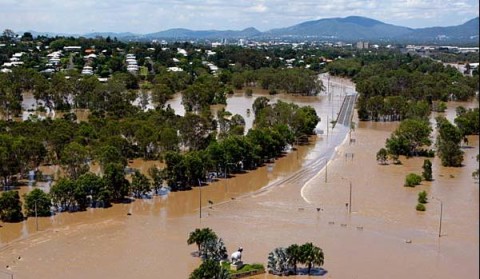 Rockhampton Flood @ 9.2m in 2011 Rockhampton Flood @ 9.2m in 2011
.
Rockhampton is again under flood along with many townships of central Queensland.
Today [5th Jan 2011] Queensland Premier Anna Bligh estimated that the total economic impact of the flood damage to Queensland could be $5 billion. Julia Gillard has previously said the Federal Government would be providing assistance that would run into the hundreds of millions to assist the recovery process. Clearly that falls well short of the $5 billion minimum estimated by the Queensland Premier.
And now the politicians are promising, pontificating and filibustering. The political party that herald’s itself as representative of rural Australians, the National Party, has called for a national disaster fund set up and that it be contributed by a household insurance levy. NSW Nationals Senator John Williams said Senator Boswell’s insurance levy should be replaced by a levy on council rates to catch all landowners.
Senator Williams has called for a debate around a national “emergency fund” of up to $10 billion that would help in the event of a flood or other disaster like drought, fire or earthquake.
“Bring on the debate, the money has to come from somewhere. We can’t just pluck it off trees,” he said. “I think a national fund would be a great step forward so the money is there when a fellow Australian is in need of it. There will obviously be some impact on the Australian economy but I would think the Australian economy is large enough and robust enough, as it does almost every year, to be able to cope with these sort of natural disasters,” he said. [1]
.
So serious is this round of disasters in Queensland, Australia’s Prime Minister ‘Julia Gillard ‘has ordered more government funds be diverted to flood-ravaged Queensland in a bid to prevent the state slipping into a long economic slump.’
‘In what may become Australia’s largest and most costly rebuilding operation, clean-up grants of up to $25,000, along with low-interest loans, were offered by the Prime Minister yesterday in addition to the commonwealth’s normal emergency relief payments. Production has almost ground to a halt in the coal industry, while early assessments of Queensland’s agriculture sector have put the cost of the floods at more than $1 billion in lost production.
Authorities also worry that receding floodwaters will reveal unexpected damage to infrastructure, raising the political pressure on all levels of government to chart a clear course to recovery.’ [2]
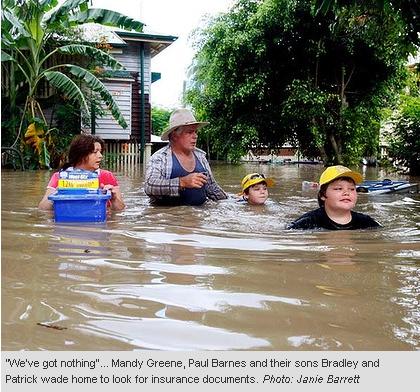
.
.
National Disaster Management Grossly Neglected in Australia
.
But yet again, after another natural disaster politicians cry to escape all implications of government culpability and so distract public attention by claim of ‘act of God‘ and ‘unprecedented‘ and calling for Australians to chip in and dig deep. Instead of confidently relying upon years of government investment in contingency planning and infrastructure, politicians become shy and distractingly appeal for ‘community spirit’. But now what choice does the community have now that a disaster is upon them? They only have community spirit, despite the bleeding guv’ment.
The floods have also badly affected New South Wales, the Gascoyne and western Victoria. This has included the NSW border town of Goodooga ‘which lies directly in the path of the Queensland floodwaters and is expected to be isolated by the weekend and could remain cut off for the next six weeks.’ The NSW Premier Kristina Keneally has said that evacuations are already underway. The NSW government has declared another eight local government areas to be natural disaster areas, bringing the total to 59. [3]
Also currently occurring is the severe flooding of the Gascoyne Region including the town of Carnarvon, 900km north of Perth. The State Fire and Emergency Services Authority is similarly advising residents to watch for changes in water levels and be ready to evacuate.’ [4] On 19th December 2010, the river had reached 7.7 metres and the president of the Carnarvon Shire, Dudley Masien described the flood the worst he had witnessed. “The hotel roof is only just peaking out of the water“, he said. [AAP 20101220].
Meanwhile in South Australia, over the 2011 New Year period temperatures had been forecast to be 40 degrees Celsius threatening “catastrophic conditions” for bushfire. Luckily an early change averted this risk, but even so several major fires have occurred across South Australia in the past few days including grass fires at Kangarilla, Salisbury East and Keith. The SA Country Fire Service has warned of very high danger ratings remain in place for the North-West Pastoral, North-East Pastoral, West Coast, Eastern Eyre Peninsula, Flinders, Mid-North Yorke Peninsula and the Riverland. [5]
Seriously, Australian governments at all levels need to stop their ‘too-little-too-late’ reactionary responses to emergency management in Australia . The Australian people, the Australian economy and the Australian natural environment deserve better. Currently, we have disparate grossly underfunded State run groups largely staffed by local volunteers – volunteer rural fire services, volunteer state emergency services, and total dependence upon various charities like the Red Cross and Salvation Army.
The responsibility for emergency management throughout Australia has been run on the cheap by successive State and Federal governments since Black Friday of 1939. National Disaster Management is probably the most neglected responsibility of all government services, because to do it right involves long term planning beyond election cycles and costs so much money.
 Do we love our ‘sun burnt country‘? Do we love our ‘sun burnt country‘?
http://poeartica.blogspot.com/2009/02/my-country.html
.
Since Victoria’s catastrophic and multiple Black Saturday bushfires about this time two years ago, Australia has emerged from decades of prolonged drought across many states; as well as experienced wild damaging storms; and bushfires this summer in South Australia and WA (again deliberately lit). Australia has copped cyclonic conditions across the north and now flooding rains throughout central and southern Queensland and into northern regions of New South Wales. Each new year that comes the risk of damaging weather is not likely to wane.
Last September, Australia’s closest neighbour, New Zealand, suffered a devastating earthquake in Christchurch, and we don’t have to travel far back to recall the 2004 Indian Ocean Tsunami that devastated coastal Sumatra, Thailand, Sri Lanka and the Maldives.
Australia has a litany of disasters through its recent history:
- March 1899: more than 400 die in Cyclone Martha at Cape York, far north Queensland.
- December 1916: Flood kills 61 at Clermont, Queensland
- April 1929: Northern Tasmanian floods kill 44
- December 1934: Melbourne floods kill 36 and leave 3000 homeless
- March 1935: Cyclone in Broome, West Australia kills 141
- February 1955: Hunter Valley floods kills 25 in Singleton and Maitland, NSW
- February 1967: Tasmanian bushfires kill 62, most in Hobart
- January 1974: Brisbane floods kill 14 (Cyclone Tracy 25,000 made homeless)
- December 1989: Earthquake in Newcastle, NSW kills 13
- July 1997: Landslide at Thredbo, NSW kills 18
- February 2009: Black Saturday bushfires in Victoria kill 173
- and many others.
[Source: The Australian newspaper, ‘Summer, season of catastrophe’, 20110112, p.11]
.
What is Australia doing about National Disaster Management on its own doorstep and to prepare its poorer neighbours in the South West Pacific? Australia as a rich wealthy nation has a moral responsibility to harbour its close exposed neighbours.
But what disaster monitoring and preparation strategy does Australian have for weather research & monitoring, disaster contingency planning, investment in defensive infrastructure to ensure community resilience, damage mitigation, natural disaster response training?
Where is Australian political leadership in national emergency management?
Australia has a recurring pattern of natural disasters. Simple searches on Google reveal that weather history in Australia is only repeating itself. It’s not new. It’s not ‘unprecedented‘ as government politicians try to excuse their leader’s unpreparedness, or is it disinterest?
Classically in Australian literature, Dorothea Mackellar’s Australian epic poem ‘My Country’ prevails and I borrow the following pertinent excerpt, which is prone to regurgitated reference by the media:
“I love a sunburnt country,
A land of sweeping plains,
Of ragged mountain ranges,
Of droughts and flooding rains.
I love her far horizons,
I love her jewel-sea,
Her beauty and her terror —
The wide brown land for me!”
.
But bear in mind Mackellar wrote that poem back in 1904. She was insightful! Colonial Australia struggling out of raw survival in a retched landscape and through someone’s noble sense of ‘Federation’, Australians will have felt the natural onslaught of the ‘terror’ of natural disasters.
But surely a hundred years hence with the time and luxury of foreign lifestyle, our irresponsible governments do not deserve pardon for their gross public ineptitude.
The Australian Bureau of Meteorology has come out declaring it was well aware of the impending torrential downpour from the current La Ni√±a event and of the likelihood of extensive flooding pending for south east Queensland. Historically, La Ni√±a has always caused high flooding cross SE Queensland big river regions. Hello! So where were the Queensland Government’s risk assessment, contingency planning, infrastructure investment and community preparation to lessen the likely disaster scenarios for the big river communities? Is Bligh a joke talking?
We’re now in the 21st Century, not Mackellar’s era. Australians in all states and territories have a public right to expect that our Australian national government will dutifully properly prepare, manage and mitigate the impacts of national disasters. It is all about good governance. What do we pay taxes for if it is not for times like this?
While many of us who can take out general insurance, those insurance companies can only respond to natural disasters in a financial sense but after the disaster. But it is not the job of insurance companies to manage disaster; it is without equivocation the responsibility of government and quite simply that is why we must pay our taxes throughout our lives. Government civic infrastructure is still not in place to mitigate known historic recurring disaster risk and so since the risk remains so the proportional premium increases. Consequently, many thousands of Australians are in a Catch 22. They are not eligible or cannot afford the requisite insurance to cover their property against natural disaster because the premiums are prohibitively expensive, but they can’t sell and relocate because their property values will have plummeted.
Over the decades thousands of Australians have had their building approved by government on land with a history of natural disaster – flooding, bushfire and drought for instance. If that is not reckless enough, governments at all levels continue to renege on disaster risk mitigation and defensive infrastructure to withstand known disaster types. So in the event of these recurring natural disasters, look at the record of the Australian Government’s contingency planning and performance protecting the Australian public – their lives, property, and to Australia’s most vulnerable our wildlife and its natural habitat? Thousands of hectares of forests have been cleared across the Brisbane River that naturally would have absorbed much of the deluge. Now bare hills and hard surfaces and many thousands of storm water drains, the rains are not absorbed. Housing development continues to be approved in bush settings that are undefendable in the event of a bushfire. Agricultural approval is provided for cropping on marginal lands with repeated histories of drought and/or flood.
Unlike back in 1904, Australia in 2011 is supposedly a wealthy, technologically advanced society. Australia easily has the financial and resource capability to be disaster prepared at national level. But failure to contingency plan condemns Australians to ‘planning to fail‘. When disaster hits Australians are on their own! When a government lets down its people it has lost all legitimacy.
.
So what is ‘Emergency Management Australia’ ?
.
Nationally, Australia has no central organisation that deals with national disasters, natural or otherwise. The job is left to the relevant State Government concerned; somewhat a leftover remnant of colonialism.
There is a token agency under the Federal Attorney General’s Department, called Emergency Management Australia [compulsorily abbreviated to an acronym like most government agencies to ‘EMA‘, but the name is more impressive than the tasks it performs.
In 2005 under the Howard Government, Emergency Management Australia was on paper “tasked with co-ordinating governmental responses to emergency incidents” and with providing training [at Mount Macedon] and policy development, yet “the actual provision of most emergency response in Australia (was)… delivered by State Governments.”
[Source: http://en.wikipedia.org/w/index.php?title=Emergency_Management_Australia&oldid=32590701]
.
In November 2007 under the Rudd Government, the Emergency Management Australia focus was modified, slightly:
“On request, the Australian Government will provide and coordinate physical assistance to the States in the event of a major natural, technological or civil defence emergency. Such physical assistance will be provided when State and Territory resources are inappropriate, exhausted or unavailable.” – and they gave it an acronym ‘COMDISPLAN‘ standing for Commonwealth Government Disaster Response Plan.
[Source: http://en.wikipedia.org/w/index.php?title=Emergency_Management_Australia&oldid=174306765 ]
.
That is, in lay terms, the Australian Government will only help in national emergencies when the States can’t handle a public emergency.
Such a bureaucratic attitude is hardly proactive leadership from our wealthy developed nation!
.
In recent years, the Rudd/Gillard Government renamed the organisation Emergency Management in Australia (visit the site http://www.ema.gov.au/), which seems to have been a way of playing down its national leadership role to one of being simply an informational resource. Again, this is divulging responsibility for national emergencies to the next tier of government. Imagine if the states and territories did the same and divulged such responsibility down to local councils?
Emergency Management in Australia doesn’t even have a dedicated minister responsible. Instead, the entire responsibility is tagged on to the Federal Attorney General’s Department. Currently the task is being delegated to an ‘Acting’ Attorney-General Brendan O‚ÄôConnor and shared with Minister for Human Services Tanya Plibersek. It is as if the Australian Government has a head in the sand approach to national emergencies at home, hoping they won’t happen, but when they do, she’ll be right mate! – we’ll fob our way through it as best we can with what’s lying around.
What a bloody irresponsible approach to national emergency management! And all the government does is to encourage the thousands of Queensland residents affected by the flooding to lodge a claim for the Australian Government‚Äôs Disaster Recovery Payment ‘AGDRP‘ – another acronym!
Other reactionary responses from Canberra are currently listed on the EMA website as ‘Flood-affected residents urged to apply for assistance’, ‘Extra disaster assistance for flood-affected communities in Queensland’, a ‘Boost for Territory Disaster Resilience’, a ‘Boost for Tasmanian disaster resilience’, ‘Commonwealth response to the final report of the Victorian Bushfires Royal Commission’, and when in doubt, ring Triple Zero (000). How reassuring!
Perhaps one initiative positively worth noting is that the Council of Australian Governments (COAG) met in Brisbane on 7 December 2009 and agreed to a range of measures to improve Australia‚Äôs natural disaster arrangements. COAG recognised “the expected increase to the regularity and severity of natural disasters“, and so agreed to a new whole-of-nation ‚Äòresilience‚Äô based approach to natural disaster policy and programs.” Under a Natural Disaster Resilience Program, at Federal level we are now supposed to have Commonwealth funding for disaster mitigation works and support for emergency management will be approximately $110 million over four years.
Well at least it’s a step in the right direction – adopting a ‘whole-of-nation’ approach is long overdue. Yet the current funding scope again is classically ‘too-little-too-late‘. The politicians pontificate. How much of this $110 million will be required for the 2010 Queensland Floods disaster? How much reached the victims of the 2009 Black Saturday disaster across Victoria?
What inevitably happens is that when the disaster situation gets beyond the local volunteers and State and Federal Governments are in a lather not being able to cope, the standard response is to call in the Army? As if the Army knows better than the experienced volunteers?
But for a national government to resort to calling in the Army is a public confession that the government’s emergency management plan has utterly failed the people. At this very point government raises the white flag of failure in national emergency management. One’s government is suddenly incompetent.
And just like what the Federal Government did in Victoria after Black Saturday’s shemozzle of a disaster management, this is just what they are again doing now in Queensland. Enter Major General Mick Slater, poor bugger!
.
.
Army deployed to manage the 2011 Queensland Floods Recovery
.
On 5th January 2011, Queensland Premier Anna Bligh announced that Major General Mick Slater would lead the state’s flood recovery taskforce, as more than
200,000 Australians in 40 communities across Queensland have been impacted in some way by the floods. The Army will be tasked to rebuild houses, economies, regional communities and infrastructure. It is estimated that about 1,200 homes across Queensland have been inundated by floodwaters thus far, with another 10,700 homes affected and 4,000 residents evacuated, and the flood bill could be well above $5 billion.
But as a freshman to national disaster management, incoming Army officer Slater has revealed that despite his Army experience has not prepared him for this challenge:
…’one of his first duties will be to talk to Major General Peter Cosgrove, who headed the Innisfail rebuilding project after Cyclone Larry in 2006.
“I believe he’s returning from overseas today and I hope to speak to him tonight. This is early days for me. I’ve just been appointed to this job, but I do understand that time is of the essence as we progress down the recovery mode. However, it is very important that we get it right the first time. “If we rush in and do patch-up jobs… then we will have got it wrong. We must get it right from the start and that will take some time.”
.
[Source: ‘Army general to head flood recovery taskforce’, ABC, 5th January 2011, http://www.abc.net.au/news/stories/2011/01/05/3106898.htm ]
.
Reading between the lines, it is clear that the Army is not trained, skilled, experienced or prepared to deal with national disasters. The Army is traditionally trained to fight battles against a human enemy. It has recently evolved to deal with peacekeeping missions, but national disasters remain outside its core skill set.
Premier Bligh has recognised:
“This is a large and complex effort. It will not happen quickly. It will require all of us working together across different levels of government.”
And so once again, instead if a single national professional response, a hotch-potch of agencies is thrown together from Federal and State Governments. Volunteers and charities will play a key role and asking the public for charity has already started.
Once again a desperate government declares ineptness and phones a friend in Canberra – ‘please send in the Army and make our politicians look like we’re taking decisive action what now there’s a good chap, meet you at the club for afters’.
.
.
Australian Army Not Equipped for National Disasters
.
CRITICAL QUESTIONS: What does the Australian Army know about national disaster management? More that the State Emergency Services or Fire Brigades? I don’t think so. But the Army has resources, and that it why it is brought in. So why don’t the emergency agencies have the resources in the first place? Emergency agencies do emergencies. The Army fights wars.
.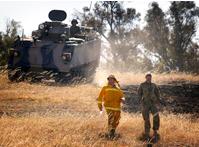
Let’s look at the record…
Army Deployed to Manage the Recovery after the 2009 Victorian Bushfire Disaster
Between 10th February and 14th March 2009, Australian Prime Minister Rudd and Victoria‚Äôs Premier Brumby agreed to have the Australian Army Reserve deployed to assist the multiple emergency services in the immediate aftermath ‘mopping up’ of the Victorian bushfire emergency, dubbed by the media as ‘Black Saturday‘. The Army set up Joint Task Force 662 based to the north of Melbourne under the command of Brigadier Mike Arnold.
Under ‘Operation VIC FIRE ASSIST’, Joint Task Force 662 involved about 450 Army Reservists in a recovery support role – mainly a construction and an engineering regiment with assistance from the School of Armour and a Combat Services Support Battalion. Specifically, ‘Search Task Group’ was set up comprising around 160 Army Reserve soldiers to assist police locate human remains with perimeter security around many townships and residents destroyed including the two Kinglakes, Strathewen, Marysville, and Flowerdale. An RAAF AP-3C Orion aircraft was deployed to provide aerial imagery to assist in the identification of residences affected by the fires.
Army support included delivering food parcels, and putting tents and facilities into place to help accommodate, feed and support people left homeless.
An Engineer Support Group, comprising around 70 personnel, five army bulldozers, a front-end loader and a grader, working with the Victorian Department of Sustainability and Environment and Country Fire Authority, to assist with improving fire breaks and containment lines, and clearing roads of vegetation and debris throughout the many bushfire affected areas.
Somewhat outside core duties, Defence personnel from Northern Command and Townsville launch bushfire undertook direct fundraising collecting donations at the gates to Larrakeyah Barracks, Northern Territory and Lavarack Barracks, Townsville. On Friday 13th February five RAAF members from Combat Support Unit Edinburgh also conducted a collection in aid of the Red Cross Bushfire Appeal at the main and south gates of RAAF Base Edinburgh.
[Source: http://www.defence.gov.au/media/download/2009/feb/20090210/index.htm ]
.
So the Army involvement in dealing with the national disaster of ‘Black Saturday‘, was effectively a post-disaster mop up operation assisting police and providing civil engineering support and relief effort. The Army was not deployed at the outset of the known bushfire risk on Monday 3rd January 2009 when weather forecast was extreme and fires had already started. Nor was the Army deployed during the disaster period itself – Saturday 9th through Monday 11th January. This is due to the Army not being best trained to deal with such emergencies and the false expectation that the volunteer Country Fire Authority were.
The emergency conditions were such:
“The majority of the fires ignited and spread on a day of some of the worst bushfire-weather conditions ever recorded. Temperatures in the mid to high 40s (¬∞C, approx. 110‚Äì120¬∞F) and wind speeds in excess of 100 kilometres per hour (62 mph), precipitated by an intense heat wave, and almost two months of little or no rain fanned the fires over large distances and areas. “
[http://en.wikipedia.org/wiki/Black_Saturday_bushfires]
.
.
Army Deployed to Manage the Response and Recovery after Cyclone Larry in 2006
Severe Tropical Cyclone Larry made landfall in Far North Queensland as a Category 4 storm crossing the coast near Innisfail at dawn on 20 March 2006. With wind gusts up to 240kph Cyclone Larry was regarded as the most powerful cyclone to affect Queensland in almost a century. In addition to the high winds, the cyclone moved inland and developed into a tropical depression causing protracted torrential rains and extensive over the following week.
The wind and flooding damage extended north to Cairns and the Atherton Tablelands and as far west as Mount Isa. After landfall, Tropical Cyclone Larry moved over north-western Queensland on 22‚Äì23 March, with heavy rain falls across the region. Most of the damage occurred in the Innisfail coastal region where 80% of buildings were damaged, power and phone lines were downed, water was contaminated and the region’s main agricultural crop, bananas, was decimated. The economic damage bill came to around A$1 billion in damage, and there was one fatality.
The usual array of disparate organisations attended the immediate emergency response including the standard local emergency services (fire brigades, ambulance and police) as well as local volunteer fire brigades (Thuringowa) and unpaid State Emergency Service volunteers. Perhaps unlike other states, the umbrella organization Emergency Management Queensland initially led and coordinated the disaster management (response and recovery) including SES, Emergency Service Units, and EMQ Helicopter Rescue.
Local councils were handed authority to enforce mandatory evacuations once Queensland Premier Peter Beattie declared Larry a ‘disaster situation’. Desperately though, even local prisoners who ‘could be trusted’ were considered for recovery and clean up work-gangs, then around 150 tradesmen from around Australia arrived in Innisfail within days to repair houses, schools and public buildings.
The Australian Army was also deployed early. Within hours of the cyclonic winds subsiding, the nearby Townsville-based 3rd Brigade and Cairns-based 51st Battalion were deployed as well as the Far North Queensland Regiment. Three UH-60 Black Hawk helicopters were reserved for rescue and logistical support. A Combat Services Support Battalion was set up to manage the disaster relief effort based at Innisfail Showgrounds to provide basic food, water, shelter and sanitary needs to evacuated residents. Onsite health care, environmental advice, fresh food and purified water (as well as testing local supplies), tarpaulins, bath and shower facilities, and up to 500 beds were provided.
The Navy and Air Force were also deployed including a CH-47 Chinook heavy lift helicopter, one Seahawk helicopter, three Navy Balikpapan class LCH Landing Craft, two Caribou aircraft, two C-130 Hercules, and several LARC-V amphibious 4WD vehicles.
By 23rd March, three days after the cyclone hit, Prime Minister John Howard and Premier Beatty appointed former Chief of the Australian Defence Force, General Peter Cosgrove, to take charge of recovery efforts labelled the ‘Cyclone Larry Taskforce‘. One quick decision made by Cosgrove was to call for an economic assessment by state and federal governments, and specified a moratorium on businesses’ debt repayments to banks for 3 months. (An outside the Army square type of thinking).
[Source: http://en.wikipedia.org/wiki/Cyclone_Larry]
Previously as a Major General in the Army, Cosgrove had successfully managed the 1999-2000 complex UN INTERFET peacekeeping taskforce in East Timor dealing with post-war humanitarian and security crisis. He was credited with commanding thousands of personnel from many countries and completing a successful mission to transition the country to relative stability.
[Source: http://en.wikipedia.org/wiki/INTERFET]
.
This experience had given Cosgrove disaster management skills beyond traditional Army combat roles, and clearly had well prepared him to lead the Cyclone Larry Taskforce. But Cosgrove’s peacekeeping civil emergency experience in a complex environment singled him out as the best person to lead the management of a national disaster in Australia. His success ought to serve as a model for future emergency management planning.
Yet Cosgrove’s experience is atypical of the Australian Army’s broader experiences. The Army’s role and experience in national disasters has been purely responsive and supportive. The main contributions by the Army in national disasters has been using Army equipment and military training to try to help a civil emergency. Following desperate orders from the Prime Minister of the day, the Army responds the best it can with what it has got in a situation it is not expertly trained or resourced to do professionally. The Army’s role in emergency management is not strategic, national nor involved in risk assessment, contingency planning nor leadership of the emergency response. But it should be.
The Australian Regular Army and its volunteer Army Reservists are tasked for traditional military combat, not for the new emerging role of international peacekeeping, nor for managing civil unrest, nor for anti-terrorism, nor for natural and national disaster management. Yet recent world events and trends point to such roles becoming more important and likely than traditional military combat. So the role of the Army, its capabilities and its culture need to change to better meet Australia’s true ‘defence’ needs in the broader 21sst Century context. The Army’s 20th Century traditional military combat role belongs to the 20th Century.
.
.
Irresponsible to Expect State-based Volunteers to Manage National Disasters
.
Tropical cyclones are not new in northern Queensland nor indeed across northern Australia. They invariably occur every Wet Season generally between the months of November and April and each year only varies in their intensity. This author experienced Cyclone Joy back in 1990 while living in Cairns. The need for a national disaster management organisation probably dates back to Cyclone Tracy of Christmas 1974 which flattened Darwin.
.
 Darwin following Cyclone Tracy at Christmas 1974
© Film Australia. http://www.abc.net.au/aplacetothink/html/cyclone.htm Darwin following Cyclone Tracy at Christmas 1974
© Film Australia. http://www.abc.net.au/aplacetothink/html/cyclone.htm
.
Australian natural history is one of recurring natural disasters. Current flooding along the Murrumbidgee River in New South Wales is again affecting the town of Gundagai, but since Australian history is poorly taught these days, few will be aware that a major flood back in 1852 wiped out the original town site of 71 buildings, and 89 of the town’s 250 inhabitants perished.
Bushfires, severe storms and cyclones, prolonged droughts, flooding rains, and even earthquakes have frequented the landscape, almost annually. With climate change apparent, however caused, there is every expectation from climate science that extremes of weather in Australia, around the world and in our region, will not lessen but more probably will increase both in frequency and severity. New forms of natural disaster may also occur in future such as tsunamis, landslide (recall Thredbo 1997), storm surge, even possible tornado or tsunami, a volcanic eruption from our north or plague and pestilence. National disasters affecting Australia and our region may also not only be naturally caused, such as a major bridge collapse, major dam collapse, major gas explosion and given ongoing tensions and terrorist events pervading our now global society, new forms of national disaster may loom.
While the 1939 ‘Black Friday’ bushfires in Victoria killed 71 people, the accompanying heat wave – which triggered the blazes – claimed 438 lives and yet remains largely unacknowledged. With climate change, a recurrence is almost certain.
Is Australia prepared to cope, manage and mitigate the effects of national disasters? Is the current emergency management framework centred on State-based and local volunteers adequate to the task?
In localised low grade emergencies, the current system generally copes well. But when it comes to national disasters like Cyclone Larry, Black Saturday and the 2011 Queensland Floods, the answer is clearly ‘no’. The test is, do most Australians believe that the emergency authorities in each case were sufficiently prepared and resourced and adequately responded? Do most Australians believe that the impacts of these national disasters could have been considerably mitigated by better risk assessment, contingency planning, the immediacy and appropriateness of the response and co-ordination of recovery?
Such questions go the core of Australia’s national security and to the role and expectation of government to protect its people and assets. The concept of ‘national security‘ needs to extend beyond the narrow military sense to encompassing defence against all forms of adverse impact to our society, economy and environment. National security also extends to Australia’s immediate region; since to ignore national disasters of our neighbouring nations would be not only immoral but likely have spillover effects on Australian eventually.
So what to do about the problem of recurring national disasters?
Government urban planning, human settlement approvals and investment in civic infrastructure to properly protect its citizens from the impacts of national disasters, and the funding of general and life insurance are interrelated key socio-economic issues that will likely come to the fore as communities recognise history repeating itself and governments are found wanting – but they are a focus is for another article.
The contention in this article is not to criticise the work of emergency service volunteers and professionals of the many organisations that get involved, but rather to highlight that the framework and resources in which they operate is woefully inadequate. Volunteers must feel like pawns in a loosely run reactive system, but culturally they are condemned if they dare criticise.
Yet the repeated evidence is that Australia’s current emergency management framework fails the delivery and performance expectations of Australians in our wealthy and advanced society. Look at the records since the first national disaster of the 1939 Black Friday bushfires! Below in the Further Reading section, a number of online references provide links to the many national disasters throughout Australian history. Natural history is repeating itself, but regrettable so is the laissez faire, even ‘head-in-the sand’ attitude of successive Australian governments to avoid serious investment and planning in emergency management for national disasters.
National disasters are costing Australian lives, communities, economies and environments. The full triple-bottom-line costs (direct and indirect) cumulatively reach the billions almost annually. The cost has to be paid in one way or another and often it is in the form of economic loss, decline in rural society and environmental degradation. Instead of governments investing billions up front to mitigate the damage and costs, governments are forking out afterwards anyway and Australian morality is tweaked to donate in order to make up the funding shortfall. The old adage of ‘prevention being better than the cure‘ holds so true here, but the solution seems beyond the short term narrow thinking of our political leaders.
.
‘So serious is this round of disasters in Queensland the Prime Minister ‘Julia Gillard has ordered more government funds be diverted to flood-ravaged Queensland in a bid to prevent the state slipping into a long economic slump.’
.
In what may become Australia’s largest and most costly rebuilding operation, clean-up grants of up to $25,000, along with low-interest loans, were offered by the Prime Minister yesterday in addition to the commonwealth’s normal emergency relief payments. Production has almost ground to a halt in the coal industry, while early assessments of Queensland’s agriculture sector have put the cost of the floods at more than $1 billion in lost production.’
.
[Source: ‘PM Julia Gillard to help flood-hit Queensland weather storm‘, by Sean Parnell and Jared Owens, The Australian, 4th January 2011. http://www.theaustralian.com.au/national-affairs/pm-julia-gillard-to-help-flood-hit-queensland-weather-storm/comments-fn59niix-1225981305357 ]
.
“Surely it’s time for Julia Gillard to stop seeing the Queensland floods as a series of media opportunities and start showing some practical leadership. She does not appear to have had the truly national implications of this disaster made clear to her.”
[Source: David Williams, Frewville, SA, Letter to the Editor, The Australian, 20110112, p13)
.
.
Full Costs of National Disasters Many Times Greater than Government Investment in its Volunteer Emergency Management Model
.
 http://on-walkabout.com/tag/bushfires/
. http://on-walkabout.com/tag/bushfires/
.
Economic Cost of National Disasters of Living Memory
In terms of direct economic damage alone, in Australian dollars the Queensland Bligh Government has estimated the cost of the current 2011 Queensland Floods to exceed $5 Billion. The economic damages bill for the 2009 Victorian Bushfires exceeded $2 billion. The economic cost of the 2006 Cyclone Larry was in excess of $1.5 billion. The 2003 Canberra Bushfires insurance cost came to $250 million. The 1991-95 drought across in north-eastern New South Wales and much of Queensland cost the economy around $5 billion.
In 1990, over one million square kilometres of Queensland and New South Wales (and a smaller area of Victoria) were flooded in April 1990. The towns of Nyngan and Charleville were the worst affected with around 2,000 homes inundated. Six people were killed and around 60 were injured.
The insurance claims payouts from the 1983 Ash Wednesday Bushfires for Victoria and South Australia combined were $1.3 billion (2007 adjusted terms). The preceding four-year drought across south-eastern Australia (1979-1983) cost the economy around $7 billion mainly in agricultural losses.
In January 1974, the weakening Cyclone Wanda brought heavy rainfall to Brisbane and many parts of south-eastern Queensland and northern New South Wales. One third of Brisbane’s city centre and 17 suburbs were severely flooded. Fourteen people died and over 300 were injured. Fifty-six homes were washed away and 1,600 were submerged. At Christmas 1974 Cyclone Tracy killed 65 people and caused over 600 injuries in Darwin and 70% of all houses had serious structural failure. The total damage bill was around $800 million (1974 $s). In 1970 Tropical Cyclone Ada caused severe damage to resorts on the Whitsunday Islands, Queensland. Fourteen people were killed and the damage bill was estimated at $390 million.
Many other national disasters have occurred in Australia as well as in neighbouring countries. The 2004 Indian Ocean Tsunami claimed more than 150,000 people dead or missing and millions more were homeless in 11 countries, making it perhaps the most destructive tsunami in history. An estimate by the World Bank and Indonesian government put the total bill for the destruction of property and businesses at more than US$4.4 billion.
[Sources: Various references online, most notably http://www.cultureandrecreation.gov.au/articles/naturaldisasters/ ]
.
Many minor emergencies that occur each year particularly involving storms and bushfires would add to the aggregate costs of these major events.
So a broad brush stroke estimate of the direct economic costs alone of national disasters affecting Australia would average in the range of between $2 billion and $5 billion per year. This excludes the social costs of people experiencing trauma and losing loved ones and livelihoods as well as the unknown environmental costs which should be measured and included and disclosed by the Australian Government so that the cost truth of national disasters is know to the Australian public. Without triple bottom line measurement, the true scale of the problem remains hidden and the ability to problem solve and to make cost effective and cost benefit investment decisions is greatly diminished.
.
Disaster Compensation
So in the current instance involving the 2011 Queensland Floods, Prime Minister Gillard has promised a $25,000 grant to each flood-affected property owner and $15,000 to those similarly affected in the flooded Gascoyne Region of Western Australia. Assumedly, flood-affected property owners in northern New South Wales will be similarly compensated. Under Queensland’s Natural Disaster Relief and Recovery Arrangements (NDRRA) the State and Federal Governments share the compensation costs and include other Disaster Relief Measures such as providing Counter Disaster Operations and a Personal Hardship Assistance Scheme (to alleviate personal hardship), an Associations Relief Assistance Scheme, Restoration of Public Assets, Concessional Loans to Primary Producers, Freight Subsidies to Primary Producers, and Concessional Loans to Small Businesses.
[Source: Queensland Disaster http://www.disaster.qld.gov.au/support/ ]
.
But the financial compensation offered by the Australian government varies with each national disaster and the aggregate cost information is not readily available online, perhaps intentionally. In the main, each state government sets up a range of compensation funds on a disaster event basis. The Australian Government provides a website Disaster Assist that summarises what compensation is available for a given disaster event, usually with references to CentreLink and back to the relevant state government. Visit: http://www.disasterassist.gov.au/www/disasterassist/disasterassist.nsf/
In the case of the 2011 Queensland Floods disaster, an Australian Government Disaster Recovery Payment rate is $1,000 per eligible adult and $400 per child.
“Claims for this assistance can be lodged at Centrelink until 4 July 2011 as application for the payment is available for a period of up to six months.”
Identified Disasters on the website are listed as follows:
Current Disaster Assistance
* Queensland Floods – December 2010
* Financial assistance for flooding and severe weather events November – December 2010
* NSW Flooding – October 2010
* South East Queensland Flooding – October 2010
* New South Wales Weather Event – September 2010
* Victorian Flooding – September 2010
* Victorian Bushfires – January/February 2009
.
Previous Disasters
* Victorian Storms – March 2010
* Queensland Floods – March 2010
* WA bushfires December 2009
* Mid-North Coast Flooding – November 2009
* Samoa Tsunami – September 2009
* Human Swine Influenza (H1N1) Outbreak 2009
* New South Wales Floods – March 2009
.
Annual Funding in Australian Emergency Management
On 12th May 2009, the Rudd Federal Government issued a media release entitled ‘Improving Disaster Resilience‘ as part of the Federal Budget 2009-2010. It stated:
‘The Rudd Government will invest $79.3 million to strengthen efforts to prepare for and combat major natural disasters.
A comprehensive ‘Disaster Resilience Australia Package’ will integrate a number of existing emergency management grant programs, providing the flexibility to effectively meet the requirements of local communities threatened by disaster. The additional funding will be part of this new package.
…The package will integrate the current Bushfire Mitigation Program (BMP), Natural Disaster Mitigation Program (NDMP), and the National Emergency
Volunteer Support Fund (NEVSF). The funding will:
-
support disaster mitigation works including flood levees and fire breaks
-
assist Local Government meet its emergency management responsibilities
-
support the work of volunteers in emergency management
-
build partnerships with business and community groups to improve their ability to respond to emergencies.
…In addition, the Commonwealth will also provide more than $12.8 million over the next four years to assist States and Territories lease additional fire fighting aircraft for longer periods during bushfire seasons.
Aircraft will be leased through the cooperative National Aerial Firefighting Arrangements (NAFA) and will help individual States and Territories access a range of specialised aircraft that would otherwise be out of reach.
“Aerial firefighting has emerged as a valuable tool in the fight against bushfires and the national arrangements have proven to be an efficient, collaborative approach that shares the cost of these specialised assets,” Mr McClelland said.
This additional funding brings the Government’s total contribution to the National Aerial Firefighting Arrangements to $14 million per year from 2009-2010.
Following recommendations of the 2008 Homeland and Border Security Review, the Government will also establish new briefing facilities and establish an enhanced Government Coordination Centre to support decision-making in the event of a national crisis or major natural disaster.’
[Source: Australian Government – Attorney General’s Department]
.
On 8th June 2010, the New South Wales Keneally Government announced it would invest $972 million in emergency services across NSW, including the NSW Fire Brigade, NSW Rural Fire Service and NSW State Emergency Services.
The NSW Emergency Services Minister, Mr Whan states:
“Our emergency services are our first line of defence against storms, floods, tsunami, fires and other emergencies and it is vital that they have the personnel, facilities and resources they need to protect communities around NSW.”
“…Over the past two years, our SES volunteers have responded to a string of emergencies, including major floods in Northern NSW, the Central West and Far West.
“Given the predicted impacts of climate change, this workload is expected to increase in coming years and it is important that the SES is ready to face the challenges ahead.”
The Budget highlights for the emergency services were listed as follows:
NSW Fire Brigades (professionally paid)
The NSW Fire Brigades 2010/11 budget is $637 million. Spending includes:
* $18 million for more than 35 new fire engines and specialised vehicles
* $8.4 million for firefighting and counter terrorism plant and equipment
* $10 million for Cabramatta and renovated fire stations and training facilities
* $2.5 million for Community Fire Units
* $1.3 million for a Workplace Conduct and Investigation Unit
.
NSW Rural Fire Service (largely unpaid volunteers)
The Rural Fire Fighting Fund for 2010/11 is $220.4 million. Spending includes:
* $32.2 million for about 200 bush fire tankers
* $16 million for new and renovated stations and fire control centres, including installing water tanks
* More than $17 million for bush fire mitigation, including $6.7 million for works crews
* $7.8 million for aerial firefighting resources
.
NSW State Emergency Service (largely unpaid volunteers)
The State Emergency Service budget for 2010/11 is $64.1 million. Spending includes:
* $2 million to assist with the cost of about 60 emergency response vehicles
* $1.4 million for rescue equipment, including $600,000 for about 20 floodboats
* $1.4 million for communication and paging systems
* $930,000 towards the cost of upgrading unit headquarters around NSW
[Source: http://www.nswfb.nsw.gov.au/news.php?news=1656 ]
.
The division of emergency services management by the State of NSW into three separate governments agencies, of which only the urban-based fire brigade is fully professionally paid, is typical of the other Australian states and territories. NSW is the most populous state in Australia and so has the greatest taxation revenue with which to fund its public services such as emergency services. An actual annual aggregate figure of the combined capital and recurrent expenditure on emergencies services across Australia would be welcomed and should be disclosed on the Australian Government’s website.
But for a quick comparison, let’s assume that the annual aggregate investment by governments at all levels across Australia, including that of local councils is in the range of $3 billion to $4 billion per year. The investment is almost on par with the economic cost outlay of Australia’s national disasters. It is important to recognise that the funding cost is separate from the disaster economic cost, and that the socio-environmental costs are excluded.
So Australia’s total economic spend on national disasters and civic emergencies probably averages close to A$10 billion per year.
.
.
A Case for Disaster Management to be ‘professionally nationalised’ across Australia.
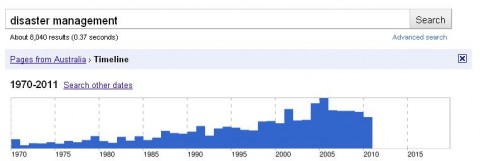 Google Search on ‘Disaster Management‘ (globally) Google Search on ‘Disaster Management‘ (globally)
.
First some problem solving questions:
- Why are national disasters causing such massive impact on Australia’s environment, society and economy?
- Is the damage caused by natural disasters impossible to mitigate (a fatalistic acceptance), or can more be done to mitigate their damage to the environment, society and economy?
- Does Australia have a history of natural disasters and are any of the recent ones socalled ‘unprecedented‘ or are they just a repeat of what has gone before and even less severe than previously?
- Who is responsible for planning and mitigating the impact of national disasters when they do occur?
- Is not national disaster management as vital a function as military defence?
- Is the current framework of multiple disjointed independent State and locally based organisations the most effective and efficient structure to do the job?
- What if Australia’s Defence Force had the same framework and organisational structure as current emergency management? Could Australia’s Defence Force perform the same as it currently does? Why not?
- How is current disaster contingency planning and response performance measured and are the measures appropriate to quantifying the desired standards of performance?
- Is the current disaster contingency planning and response performance acceptable to the Australian community?
- How short of ideal is the current performance?
- Why is the current emergency management response not able to mitigate the impact to an acceptable level?
- How do Australia’s emergency management operations measure up against world best practice?
- What countries have world best practice emergency management?
- Does the funding structure facilitate or inhibit the capacity of the emergency planning and response?
- Are grants and subsidies an appropriate revenue source for such a vital service?
- Ought funding be guaranteed as it is with the Defence Forces?
- What are the alternatives to Australia’s current disaster contingency planning and response framework?
- Do other countries have a proven success record of disaster contingency planning and response, which Australia could learn from and adapt?
.
.

United States: Federal Emergency Management Agency
.
Probably the global best practice structure currently for dealing with national disaster management (from risk assessment through reconstruction phasing) exists not surprisingly with the United States of America. Try searching elsewhere and frankly, the US is hard to beat.
The United States National Response Framework (NRF) is part of the National Strategy for Homeland Security that presents the guiding principles enabling all levels of domestic response partners to prepare for and provide a unified national response to disasters and emergencies.
Until 1979,the United States had no comprehensive plan for federal emergency response. Then President Jimmy Carter signed an executive order creating the Federal Emergency Management Agency (FEMA), which consolidated the emergency response duties from multiple agencies across the country that each had disjointed emergency operational plans. National legislation was enacted in 1988 to effectively nationalise Federal response to disasters. Under the National Contingency Plan, multiple organisations were united to deal with disaster preparedness and response.
In 1992, US President Bill Clinton appointed James Lee Witt as the head of FEMA, who substantially changed FEMA to adopt an all-hazards approach to emergency planning. Clinton elevated Witt to a cabinet-level position, giving the Director access to the President. So for the first time, a national disaster management organisation had a National Response Plan and reported directly to the head of the US government – the President.
Since then, following the 2001 September 11 terrorist attacks, the United States thrust disaster management to the forefront of national priority for obvious reasons and it is due to this that the United States probably more than any other country, bar perhaps Israel, has a world leading disaster management structure today. Since 2003, the Department of Homeland Security has absorbed FEMA and since 2008, the National Response Plan has been replaced by the National Response Framework.
Check out: US Federal Emergency Management Agency and FEMA National Response Framework [NRF]
The United States National Response Framework (NRF) is part of the National Strategy for Homeland Security that presents the guiding principles enabling all levels of domestic response partners to prepare for and provide a unified national response to disasters and emergencies. Building on the existing National Incident Management System (NIMS) as well as Incident Command System (ICS) standardization, the NRF’s coordinating structures are always in effect for implementation at any level and at any time for local, state, and national emergency or disaster response.
.
.
NRF five key principles
.
- Engaged partnership means that leaders at all levels collaborate to develop shared response goals and align capabilities. This collaboration is designed to prevent any level from being overwhelmed in times of crisis.
- Tiered response refers to the efficient management of incidents, so that such incidents are handled at the lowest possible jurisdictional level and supported by additional capabilities only when needed.
- Scalable, flexible, and adaptable operational capabilities are implemented as incidents change in size, scope, and complexity, so that the response to an incident or complex of incidents adapts to meet the requirements under ICS/NIMS management by objectives. The ICS/NIMS resources of various formally-defined resource types are requested, assigned and deployed as needed, then demobilized when available and incident deployment is not longer necessary.
- Unity of effort through unified command refers to the ICS/NIMS respect for each participating organization’s chain of command with an emphasis on seamless coordination across jurisdictions in support of common objectives. This seamless coordination is guided by the “Plain English” communication protocol between ICS/NIMS command structures and assigned resources to coordinate response operations among multiple jurisdictions that may be joined at an incident complex.
- Readiness to Act: “It is our collective duty to provide the best response possible. From individuals, households, and communities to local, tribal, State, and Federal governments, national response depends on our readiness to act.”
.
.
‘NRF CORE’
.
- Roles and responsibilities at the individual, organizational and other private sector as well as local, state, and federal government levels
- Response actions
- Staffing and organization
- Planning and the National Preparedness Architecture
- NRF implementation, Resource Center, and other supporting documents incorporated by reference
.
.
NRF ANNEXES
.
* ESF #1 – Transportation
* ESF #2 – Communications
* ESF #3 – Public Works and Engineering
* ESF #4 – Firefighting
* ESF #5 -Emergency Management
* ESF #6 – Mass Care, Emergency Assistance, Housing, and Human Services
* ESF #7 – Logistics Management and Resource Support
* ESF #8 – Public Health and Medical Services
* ESF #9 – Search and Rescue
* ESF #10 – Oil and Hazardous Materials Response
* ESF #11 – Agriculture and Natural Resources
* ESF #12 – Energy
* ESF #13 – Public Safety and Security
* ESF #14 – Long-Term Community Recovery
* ESF #15 – External Affairs
.
.
NRF SUPPORT ANNEXES:
.
* Critical Infrastructure and Key Resources (CIKR)
* Financial Management
* International Coordination
* Private-Sector Coordination
* Public Affairs
* Tribal Relations
* Volunteer and Donations Management
* Worker Safety and Health
.
.
NRF INCIDENT ANNEXES:
.
* Incident Annex Introduction
* Biological Incident
* Catastrophic Incident
* Cyber Incident
* Food and Agriculture Incident
* Mass Evacuation Incident
* Nuclear/Radiological Incident
* Terrorism Incident Law Enforcement and Investigation
.
.
.
Proposed New Defence Corps: Australia’s ‘Civil Emergency Corps‘
.
As one solution to Australia’s failing governance of national disasters, I propose the complete overhaul of Australia’s current state-based and volunteer based disparate organisations, by consolidating, nationalising and professionalising them all into one. I propose a new national defence corps be established under new national legislation – Australia’s ‘Civil Emergency Corps‘. This Corp would be an equal partner with our Army, Navy and Air Force, but instead of focusing on national defence against human-based threats, the Civil Emergency Corps will focus on national defence against mainly natural threats.
.
A special national commission should be established by the Australian Government to review and shape the purpose, functional scope, framework, organisation structure and strategies of this new corps. The initial intent is that this Civil Emergency Corps is to be modelled along the lines of the United States Federal Emergency Management Agency (FEMA) and the Federal National Response Framework (NRF), but tailored to Australia’s specific needs and circumstances. The design of the organisation will be based on input received from current emergency personnel, emergency experts and from the broader Australian community. Ideas from comparable organisations overseas will also be considered, such as from nations having proven effective national civil defence organisations.
Funding is to be on par and have the same budget process as the Australian Regular Army. No more raffles, grants and fund raising. The organisation would be professionally paid, run in a military structure and discipline. Like the Army it would have core full-time regulars and a part-time reserve component. It would be initially staffed by the current people already performing emergency service work. Over time the organisation will evolve to coming up to par with the equivalent performance standards as the Army. It’s resourcing would be exponentially increased to equip it to being a national effective fighting force to deal with national emergencies, properly.
.
Essential Functions of the Civil Emergency Corps
.
- All the work of the State Emergency Services, Fire and Rescue Agencies
- Disaster Risk, Contingency, Mitigation Planning – from local to national and indeed regional scale
- Natural Disaster Response ‚fire, explosion, contamination, flood, drought, storm, sea surge, earthquake, etc
- Disaster Relief
- Disaster Recovery
- HAZMAT Response
- Disaster Management Training
- Community Education in Natural Disaster Preparation and Mitigation
- Post-disaster review an analysis and recommendations for future best practice and preparation to the Federal Government
- Ongoing national disaster research input
.
Mascot
.
Australia’s magnificent wedge-tailed eagle should be the mascot of this new organisation. It is uniquely Australian, a highly respected native bird and the eagle traditionally is a symbol for guardianship, protection, power, strength, courage, wisdom and grace. All these qualities quite apt for a Civil Emergency Corps. An appropriate motto is ‘defending our community‘ – but instead of in English or translated back to Latin, better in Australian Aboriginal.
 Australia’s Wedge-Tailed Eagle
http://commons.wikimedia.org/wiki/File:Wedge_tailed_eagle_in_flight04.jpg Australia’s Wedge-Tailed Eagle
http://commons.wikimedia.org/wiki/File:Wedge_tailed_eagle_in_flight04.jpg
.
Incorporated into Australia’s Defence Context
1. Australian Regular Army / Army Reserve
2. Royal Australian Navy / Navy Reserve
3. Royal Australian Air Force / Air Force Reserve
4. Civil Emergency Corps / Civil Emergency Reserve
.
.
National Government Ministry
- Minister for Civil Emergency
- Deputy Minister for Civil Emergency
- Parliamentary Secretary for Civil Emergency
.
Organisational Structure
In the same way as Australia’s three other corps are configured, the new Civil Emergency Corps is to be comprised of ‘Regulars‘ – full-time and professionally paid, as well as ‘Reservists‘, who commit on a part-time on demand basis, who are professionally trained and paid commensurate on time served.
The organisational structure is to geographically-based into a respective ‘State Corps‘ for each State and Territory, then into ‘Regional Brigades‘ and then at local level into ‘Local Units‘. Each component will have its share of regulars and reservists. The existing infrastructure of the various emergency services agencies would be utilised.
In addition, in order to deal with highly specialised functions, dedicated Corp Specialist Regiments will be established (see proposed list below).
.
A ‘National Command Centre’
- headed by the Corps General Marshall
- based in Canberra next to the Bureau of Meteorology (BOM), for strategic reasons
.
State & Territory Corps
- each headed by a ‘Corp Brigadier’
- organisation structure based on a hybrid geographical model of both Fire Brigades and State Emergency Service, decided on a region by region assessment
.
Regional Brigades
- each headed by a ‘Regional Commander’
.
Local Units
- each headed by a ‘Unit Captain’
Note: Currently, in the New South Wales State Emergency Service (SES), NSW is divided into 17 ‘Regions’ based on major river systems.
‘Each of the 226 volunteer units belongs to a Region, which is led by a Region Controller. Region boundaries coincide as nearly as possible with major river systems. Each Region Controller is responsible for the operational control of emergency flood and storm responses, including planning, training, operational support and other functions within their area of control. The Region Headquarters also provides administrative support to the units in its region. The Region Headquarters all have fully functioning Operations Centres and a group of volunteers who help with training, planning, operational and other functions.’
[Source: http://www.ses.nsw.gov.au/about/ ]
.
Merger and Integration of the following national organisations into the new Civil Emergency Corps:
- Emergency Management Australia
- Care Flight Group
- Australian Volunteer Coast Guard
- St John Ambulance Service
.
.
NSW Corps
A merger and integration of the Fire and Rescue NSW, NSW Rural Fire Service, NSW Police Rescue Unit, Westpac Rescue Helicopter Service (NSW), CareFlight Group, Marine Rescue NSW, Community Emergency Services Incorporated
.
Victorian Corps
A merger and integration of the Victorian Fire Brigade, Country Fire Authority, State Emergency Service, Search and Rescue Squad (of the Victorian Police).
.
Queensland Corps
A merger and integration of the Queensland Fire and Rescue Service, Queensland State Emergency Service and Volunteer Marine Rescue, Queensland Rural Fire Service, RACQ CareFlight, Capricorn Helicopter Rescue Service (Rockhampton), Royal Flying Doctor Service, Volunteer Marine Rescue Association of Queensland.
.
South Australian Corps
A merger and integration of the South Australian Metroplitan Fire Service, Country Fire Service, State Emergency Service, South Australian Sea Rescue Squadron.
.
ACT Corps
A merger and integration of the ACT Fire Brigade, ACT State Emergency Service, ACT Rural Fire Service.
.
West Australian Corps
A merger and integration of the Fire and Emergency Services Authority of Western Australia (which has already merged its emergency service agencies), and the Volunteer Marine Rescue Western Australia.
.
Northern Territory Corps
A merger and integration of the Northern Territory Fire and Rescue Service, Northern Territory Emergency Service, Bushfire Volunteer Brigades, Rescue Co-ordination Centre (Northern Territory Transport Group).
.
Tasmanian Corps
A merger and integration of the Tasmanian Fire Service, State Emergency Service Tasmania, Tasmanian Air Rescue Trust, Sea Rescue Tasmanian Inc.
.
.
Corps Specialist Regiments
- Each specialist regiment shall have its own part-time payrolled Reserve component.
.
‘Evacuation Regiment’
- emergency field transport and logistics to effect evacuation of people and their personal effects
- assumes basic human needs provision of displaced persons (emergency accommodation, food and clothing, emergency sanitation, emergency childcare
- currently performed by charity groups like The Salvation Army, The Australian Red Cross, St Vincent de Paul Society, Anglicare Australia, Mission Australia, Catholic Mission, and others
.
‘Utilities Regiment’
- public utility repair and rebuilding – drinking water, sewage and sanitation, electricity, gas services
.
‘Reconstruction Regiment’
- debris clearance, demolition, salvage, engineering, construction, civil infrastructure, and relief housing, farm fencing repairs.
.
‘Communications Regiment’
- Corps internal communications including satellite, (attached to Army Signals), plus public communications – land phone, mobile/SMS, public broadcast services, internet services, including evacuee/missing persons database and related communications
.
‘Search and Rescue Regiment’
- assumes land search and rescue functions previously performed by various State Police special units
.
‘Maritime Regiment’
- assumes functions previously performed by Coast Guard, including sea search and rescue and vessel salvage functions
.
‘Medivac Regiment’
- assumes functions previously performed in times of disaster by State-based Ambulance Services, Royal Flying Doctior Service, Army Medics, St John Ambulance and paramedics, air-ambulance, field medicine and medical emergency evacuation, hospital transfers, disease prevention, containment and vaccinations
- Not a replacement of the State-based Ambulance Services
.
‘Community Regiment’
- provides the full range of trauma counselling, psychological and associated mental health services
.
‘Vet Regiment’
- Specialised livestock and pet recovery, animal sheltering, emergency veterinary services, emergency relief livestock agistment, stock feed provision and distribution
.
‘Biosecurity Regiment’
- All biosecurity emergency planning and response to disease outbreaks, pandemics, epidemics, pestilence, plague, national health threats or emergencies, including mass casualty events, communicable disease outbreaks, and quarantine emergency planning and response.
.
.
Civic Emergency Strategic Partners
.
- Australian Regular Army
- Engineering
- Signals (Communications)
- Logistics/Transport
- Royal Australian Navy
- Royal Australian Air Force
- Australian Bureau of Meteorology
- Australian Government Department of health and Aging – Health Emergency
- Australian Security and Intelligence Organisation
- State and Federal Governments – Premiers Departments
- New Zealand Government – Ministry of Civil Defenc and Emergency Management CentreLink
- CSIRO
- Bushfire CRC
- Seismology Research Centre, Australia
- Geoscience Australia
- Australian Broadcasting Commission
- Department of Community Services (and State equivalents)
- Major Supermarket Retailers – Coles, Woolworths, Metcash
- Shipping Container company
- Satellite Service Provider – Australian Satellite Communications Pty Ltd,
- Commonwealth Serum Laboratories (CSL)
- Telstra
- Qantas
- Brambles Shipping
- Salvation Army
- Red Cross
- Infrastructure Australia
- Ambulance Services
- State Hospitals
- Metcash, Coles, Woolworths
- LinFox, Toll Holdings,
- DOCS
- CentreLink
- State Morgues and Funeral Directors
- Business Council of Australia
- Small Business Council of Australia
- Insurance Council of Australia
and others.
.
 Nationalisation brings serious investment.
‘The world’s biggest fire-fighting plane ejects water during a demonstration in Hahn, Germany.
The altered Boeing 747 can carry more than 75,000 litres of water. California has chartered one’.
http://i.telegraph.co.uk/telegraph/multimedia/archive/01473/jumbo-jet_1473655i.jpg Nationalisation brings serious investment.
‘The world’s biggest fire-fighting plane ejects water during a demonstration in Hahn, Germany.
The altered Boeing 747 can carry more than 75,000 litres of water. California has chartered one’.
http://i.telegraph.co.uk/telegraph/multimedia/archive/01473/jumbo-jet_1473655i.jpg
.
.
Cost- Benefits
- Collectively across all the existing emergency organisations, Australia already spends billions in emergency management, but is not coping and is under-performing against 21st century triple bottom line expectations
- Cumulatively, Australia already spends billions in emergency management, but most of the cost is in response due to being underprepared. Prevention is better than the cure – cheaper economically and on lives.
- A professional organisation, on the payroll is fairer to the workers involved. Government reliance on community volunteers is exploitative and the standards can never collectively match full paid professionals with state of the art resourcing. Taxes are paid by the people so that government will protect them in both military and civil defence.
- A single national Corps is better positioned than multiple disjointed organisations to prepare for and respond to the ever increasing array of national disasters, but such an organisation would retain the critical advantage of regional and local personnel and resources. Economies of scale and efficiency gains from removing duplication in administration and overheads would come from a single Corps. But a key condition must be that any job losses would attract full retrenchment payouts.
- Many secondary school leavers could be readily recruited into a Civil Emergency Corps service for limited services, than are attracted to the traditional three military corps.
.
Can Australia afford it?
Can Australia afford not to? Wait until the next disaster and then ask the question again?
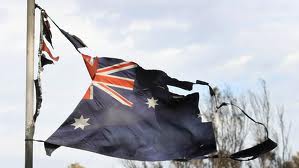
When Australians observe the hundreds of millions of dollars (indeed billions) of taxpayer moneys spent by State and Federal Governments in wasteful projects, the answer is a simple yes, easily. Question the opportunity cost of the following recent examples of government inappropriate spending and waste:
- Prime Minister Gillard donates $500 million to Indonesian Islamic Schools [^ November 2010]
- Senate inquiry into the Rudd-Gillard Government’s botched $300 million Green Loans program has confirmed that some groups of assessors hired as part of the program are still owed over $500,000 in fees due to mismanagement and poor administration procedures under the scheme with some assessors blasting the Federal Government for failing to implement proper checks and balances. [^July 2010]
- The Rudd Government has recorded an $850 million blow-out in the cost of its household solar power program. Labor had only intended to spend $150 million over five years on solar rebates but instead splurged $1 billion in just 18 months! [^March 2010]
- Queensland Premier Bligh committed $1.2 billion into the Tugun Desalination Plant, which has been plagued by problems since it opened last year, will be shut early next year, along with half the $380 million Bundamba treatment plant and the new $313 million plant at Gibson Island. Water infrastructure has cost Queenslanders $9 billion recently and they are entitled to know the money is being spent wisely. [^December 2010]
- Queensland Premier Anna Bligh shelved a $192 million project involving carbon capture research. Bligh has said she is determined to make carbon capture storage economically viable and has committed another $50 million of taxpayers money to finding the answer. The Bligh government has already spent $102 million researching cleaner coal technology through the state-owned ZeroGen, a joint state-commonwealth government and industry led-research project for coal-fired power production. [^December 2010]
- Victorian Premier Brumby’s Wonthaggi desalination plant will cost Victorians $15.8 billion over the next three decades, departmental figures show, leading the state opposition to accuse the government of hiding the project’s true cost. [^Sept 2010]
And disaster management it is better invested up front in prevention and response, than afterward in relief and recovery.
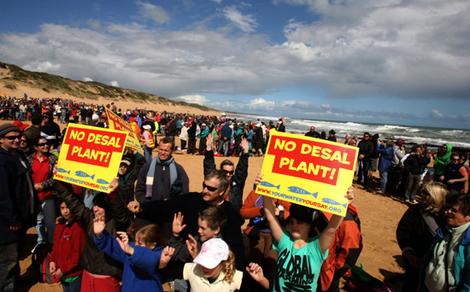
.
.
.
Further Reading:
.
[1] ‘Reform 03 ‘Formation of a Civil Emergency Corps‘, >Link
[2] ‘Nat MPs push levy for disaster fund‘, by Joe Kelly, The Australian, January 05, 2011,
http://www.theaustralian.com.au/national-affairs/treasury/nat-mps-push-levy-for-disaster-fund/story-fn59nsif-1225982479225]
.
[3] ‘PM Julia Gillard to help flood-hit Queensland weather storm‘, by Sean Parnell and Jared Owens, The Australian, 4th January 2011, http://www.theaustralian.com.au/national-affairs/pm-julia-gillard-to-help-flood-hit-queensland-weather-storm/comments-fn59niix-1225981305357
.
[4] ‘Premier visits NSW towns in flood’s path’ , ABC, 6th January 2011,
http://www.abc.net.au/news/stories/2011/01/06/3107563.htm
.
[5] ‘Carnarvon on flood warning but levees hold’, 20th December 2010, ABC
http://www.abc.net.au/news/stories/2010/12/20/3097642.htm
.
[6] ‘SA has been facing ‘very high’ fire danger’, ABC, 1st January 2011,
http://www.abc.net.au/news/stories/2011/01/01/3104707.htm
.
[7] Bushfires in Australia
http://en.wikipedia.org/wiki/Category:Bushfires_in_Australia
.
[8] Floods in Australia
http://en.wikipedia.org/wiki/Category:Floods_in_Australia
.
[9] Droughts in Australia
http://en.wikipedia.org/wiki/Category:Droughts_in_Australia
.
[10] Severe Storms in Australia
http://en.wikipedia.org/wiki/Severe_storms_in_Australia
.
[11] Cyclones in Australia
http://en.wikipedia.org/wiki/Category:Cyclones_in_Australia
.
[12] Black Saturday Bushfires
http://en.wikipedia.org/wiki/Black_Saturday_bushfires
.
[13] Earthquakes in Australia
http://en.wikipedia.org/wiki/Category:Earthquakes_in_Australia
.
[14] 1997 Thredbo Landslide
http://en.wikipedia.org/wiki/1997_Thredbo_landslide
.
[15] Role of the Australian Army
http://en.wikipedia.org/wiki/Australian_Defence_Force
.
[16] Australian Government – Natural Disasters in Australia
http://www.cultureandrecreation.gov.au/articles/naturaldisasters/
.
-end of article –
Emergency Management Australia (EMA) is an Australian Federal Government Agency tasked with coordinating governmental responses to emergency incidents. EMA currently sits within the Federal Attorney General’s Department.
Australian state and territory authorities have a constitutional responsibility, within their boundaries, for coordinating and planning for the response to disasters and civil emergencies. When the total resources (government, community and commercial) of an affected state or territory cannot reasonably cope with the needs of the situation, the state or territory government can seek assistance from the Australian Government.
On request, the Australian Government will provide and coordinate physical assistance to the States in the event of a major natural, technological or civil defence emergency. Such physical assistance will be provided when State and Territory resources are inappropriate, exhausted or unavailable. The Australian Government accepts responsibility and prepares plans for providing Commonwealth physical resources in response to such requests. Emergency Management Australia (EMA) is nominated as the agency responsible for planning and coordinating Commonwealth physical assistance to the states and territories under the Commonwealth Government Disaster Response Plan (COMDISPLAN).
The Commonwealth Government Disaster Response Plan (COMDISPLAN) provides the framework for addressing state and territory requests for Commonwealth physical assistance arising from any type of emergency. COMDISPLAN is normally activated when Commonwealth assistance for emergency response or short-term recovery is requested or likely to be requested.
After the 2009 restructure of the Federal Attorney-General’s Department, responsibility for the Australian Emergency Management Institute (formerly the Emergency Management Australia Institute) was taken over by the National Security Capability Development Division. The Institute conducts extensive emergency management education and training courses from the vocational education and training (VET) Public Safety Training Package. The programs delivered include eleven competencies which make up the Advanced Diploma in Public Safety (Emergency Management) including Emergency Coordination Centre Management, Exercise Management, Undertake Emergency Planning and Recovery Management as well as three nationally-accredited short courses: Risk-based Land Use Planning, Business Continuity Management and Emergency Management for Local Government. Program participants are drawn from the range of the emergency response agencies: fire, police, ambulance, State Emergency Service (SES) as well as local, state and Federal Government; NGOs such as the Red Cross and representatives from the private sector deemed “critical infrastructure” (i.e. water/power/transport).
Emergency Management involves the plans, structures and arrangements which are established to bring together the normal endeavours of government, voluntary and private agencies in a comprehensive and coordinated way to deal with the whole spectrum of emergency needs including prevention, preparedness, response and recovery.
Tags: Anna Bligh, Australian Regular Army, Black Saturday, Brisbane flood, bushfire, Christchurch earthquake, Civil Emergency Corps, Cyclone Yasi, defensive infrastructure, disaster contingency, Dorothea Mackellar, droughts, Earthquake, Emergency Management Australia, Emergency Services Minister Neil Roberts, FEMA National Response Framework, floods, Gascoyne flood, Goolgoolga, John Brumby, Julia Gillard, Labor Waste, Major General Mick Slater, national disaster management, national emergencies, natural disasters, Qld floods, queensland flood aftermath, Queensland Floods, Rockhampton, storms, Toowoomba flood, Victorian Bushfires 2009, Wonthaggi Desal Plant, ZeroGen
Posted in Threats from Bushfire | 2 Comments »
Add this post to Del.icio.us - Digg
|
|
 Tasmania’s magnificent ‘Weld Forest’
~ one of Tasmania’s rare ancient forests constantly threatened
by Tasmanian Government recidivist logger ‘Forestry Tasmania’
Tasmania’s magnificent ‘Weld Forest’
~ one of Tasmania’s rare ancient forests constantly threatened
by Tasmanian Government recidivist logger ‘Forestry Tasmania’
 Tasmania’s Forest Defender – Miranda Gibson
stationed in a eco-Tree Sit 60 metres above the Styx Valley Forest floor
Visit: The ObserverTree.org
…waiting for Australia’s Prime Minister Julia Gillard to honour her personal promise to Tasmanians to protect Tasmanian old growth forests for perpetuity.
.
Tasmania’s Forest Defender – Miranda Gibson
stationed in a eco-Tree Sit 60 metres above the Styx Valley Forest floor
Visit: The ObserverTree.org
…waiting for Australia’s Prime Minister Julia Gillard to honour her personal promise to Tasmanians to protect Tasmanian old growth forests for perpetuity.
.
 Australia’s 27th Prime Minister, The Hon. Julia Gillard (June 2010 – ?)
In her vital and privileged position, she has the power, influence, connections and taxpayer resources
to protect Tasmania’s 572,000 hectares of old growth native forests consistent with the IGA.
As usual, it comes down to political will, courage and innovative thinking – which is what we expect of our leaders.
Australia’s 27th Prime Minister, The Hon. Julia Gillard (June 2010 – ?)
In her vital and privileged position, she has the power, influence, connections and taxpayer resources
to protect Tasmania’s 572,000 hectares of old growth native forests consistent with the IGA.
As usual, it comes down to political will, courage and innovative thinking – which is what we expect of our leaders.
 Logging invades Tasmania’s South-West wilderness in the Huon valley,
not far downstream of the above photo.
This logging is ruining the integrity of the adjacent Tasmanian Wilderness World Heritage Area
whose boundaries have been drawn to protect the treeless mountaintops
and leave the forested valleys to the loggers.
Logging invades Tasmania’s South-West wilderness in the Huon valley,
not far downstream of the above photo.
This logging is ruining the integrity of the adjacent Tasmanian Wilderness World Heritage Area
whose boundaries have been drawn to protect the treeless mountaintops
and leave the forested valleys to the loggers.



































































